FY2025test
FY2025
City of Tallahassee Annual Budget Report
Mayor and Commissioners,
I am pleased to present the City of Tallahassee Fiscal Year 2025 (FY25) balanced budget. This budget was developed with direction provided by the City Commission through a series of public workshops and commission meeting agenda items in alignment with the City’s Strategic Plan.
The City’s budget is the framework for financial planning and management, outlining the allocation of resources and ensuring that the priorities within the City's Strategic Plan are adequately funded. The budget serves as our roadmap for expected revenues and expenditures, guiding operations and strategic initiatives to achieve the City’s short- and long-term goals. Additionally, it reflects our commitment to fiscal prudence while supporting the high quality of life our residents enjoy, expect, and deserve.
Due to fiscally responsible management, the cost residents pay for municipal services in Tallahassee is the lowest among similar-sized peer cities in Florida. Even amid challenges such as the global pandemic, economic downturns, and severe weather events including hurricanes, a flash flood emergency in April, and multiple tornadoes in May we remain dedicated to our mission to be the national leader in the delivery of public service. However, the increasing frequency and intensity of severe weather in Tallahassee has a significant impact on City resources.
Delivering on our mission, vision, and values was especially evident during disaster responses. We continue to set the standard for natural disaster response and recovery, as clearly demonstrated on May 10, when the City was hit by multiple EF-2 tornadoes. Destruction of the City’s electric grid was extensive, with over 500 broken poles and 325 damaged transformers, leaving more than 80,000 customers without power and requiring a complete rebuild of significant portions of the system. The unprecedented damage and community-wide costs resulted in an estimated $50 million in damages and recovery costs to the City. Over the past decade, the City has spent nearly $100 million on disaster preparation and storm response. While FEMA reimbursements are pursued, if approved, a typical reimbursement of 75% takes multiple years to receive. Therefore, building and maintaining adequate reserves is crucial for public safety response, electric restoration, and debris cleanup. Our proven ability to navigate the impact of storms and execute pace-setting restoration and recovery is a testament to the resilience of our organization and the strategic objectives set in place to guide operations.
Our resilience, combined with our fiscal responsibility and strategic focus, has Tallahassee primed for new opportunities as we continue to leverage the airport as a key economic catalyst; expand affordable housing; and enhance residents’ overall quality of life through parks, green spaces and recreational opportunities for all ages to enjoy. Recent noteworthy milestones and highlights include:
- Tallahassee was recognized as The Strongest Economy in the United States by Area Development, a site selection publication. The Tallahassee MSA is also ranked:
- #2 in the Top Mid-Sized Metro Locations category
- #4 in the Top South Atlantic Region category
- #9 in the Top 50 Metro Locations compared to the rest of the U.S
These rankings reflect Tallahassee’s focus on economic growth and further position the community for future economic success as one of the country’s prime areas for business investment and job creation. According to Area Development, the leading metro areas are those poised for long-term growth and are often hubs of high-tech industry, where workers may benefit from an affordable cost of living. We are already seeing evidence of this as job growth in our community is outpacing population growth, which results in real wage growth and an even stronger economy.
- The City has significantly grown the Tallahassee International Airport's economic contribution, from $399 million in 2014 to $599 million in 2019 and then surging to nearly $1 billion today. The City’s airport serves as a critical gateway for business travel, tourism, and cargo operations, and by the end of the year, nearly 1 million passengers will have passed through its modernized terminal. Passenger traffic is nearing record highs first quarter of 2024. Passenger numbers were the most for any first quarter in the past 14 years and 31% higher than the 10-year first quarter average. Progress is also being made toward completing the International Processing Facility and establishing a Foreign Trade Zone, which will create over 1,600 jobs and generate in excess of $300 million in annual economic impact.
- Affordable housing initiatives have reached new heights, marking this year the most successful in Tallahassee’s history. The City issued permits for 42 multi-family buildings, resulting in 1,143 new dwelling units. Tallahassee leads its peer cities in the per capita number of affordable housing units either under development or recently completed. Additionally, the City has supported over 13,000 lower-income residents in staying in their homes, carrying out essential renovations, and purchasing homes for the first time.
- The City’s world-class park system is growing with the addition of new parks, moving toward our strategic goal of establishing 100 parks. Tallahassee proudly manages nearly 4,000 acres of parkland and more than 80 miles of trails. Now, 92% of City residents enjoy access to a park or open space within a 10-minute walk.
- In 2024, Tallahassee is vibrant with groundbreaking celebrations as we mark our bicentennial year. Highlighting the City's commitment to growth and community enhancement, the Southside Transit Center, located at the corner of Orange Avenue and Meridian Street, is poised to be a transformative project for the area. Additionally, the redevelopment of the former Northwood site continues with the construction of a new headquarters for the Tallahassee Police Department, designed to meet operational needs and offer community amenities. Further, a second senior center is now under construction, which will address the needs of the community's expanding population of active seniors.
- The prioritization of investing in TPD has proven effective, as evidenced by a recent reduction in violent crime. Over the past year, violent crime has decreased by approximately 14%, with an even more substantial decline of 30% during the summer months. This improvement highlights the success of holistic public safety strategies for fostering a safer environment for all residents.
To accomplish these and other achievements and continue to set the standard for service, we remain focused on efficiency through continuous evaluation and streamlining of operations where possible. Through strong operational management and technology enhancements, the City is reducing costs while elevating the quality of services delivered to citizens. This requires teamwork and ensuring cross-departmental collaboration. For example, the consolidation of street and underground utility inspection services into a single unit has improved coordination, expedited response times, and expanded coverage. Moreover, the focus remains on optimizing our workforce to meet the service needs of our growing community through regular evaluations of market conditions, contract management efficiency, and overhead costs.
The FY 2025 budget reflects our commitment to being the leader in the delivery of public service, recognizing the efforts of the City’s workforce, and includes compensation set to retain, attract, develop, and support skilled talent. By investing in employee excellence, we ensure our organization remains an employer of choice and a trusted provider of essential services.
The General Fund, which is essential for supporting fundamental government services, is balanced. This provides for the continuity of essential City services like public safety, sidewalks, roads, and transportation in alignment with the Commission's strategic priorities. Updated revenue estimates reflect a stable financial outlook with the maintenance of a consistent millage rate and property taxes forming a significant portion of General Fund revenues.
The FY25 budget strategically allocates funding to address current and future service needs while further solidifying Tallahassee as a vibrant community with a strong economy in the country, and it is presented for your consideration.
Sincerely,

Reese Goad
City Manager
FY2025 Budget Overview 1.0
Introduction and Overview
1.1 Mission
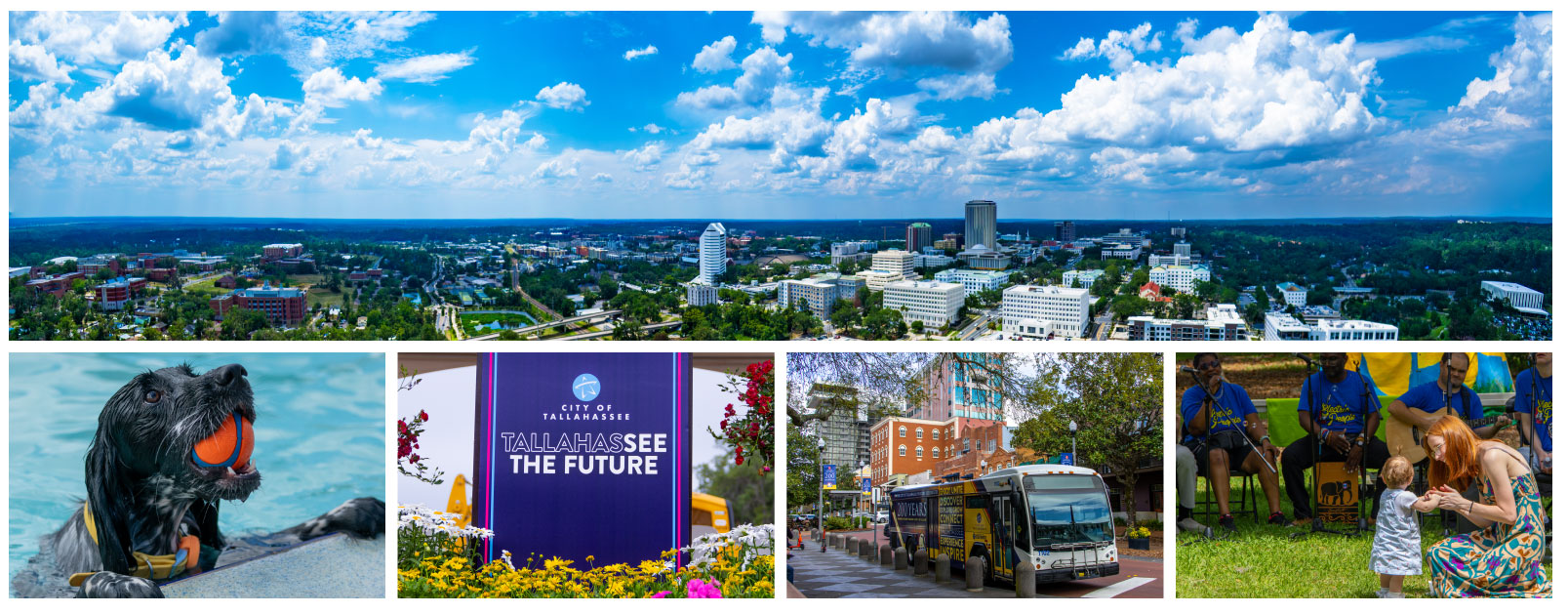
Through workshops, surveys, and commission retreats the City of Tallahassee has developed the following vision, mission, and critical success factors. These are the basis for the performance measurement process that each department has implemented.
Mission:
To be the national leader in the delivery of public service.
Vision:
A creative capital city that supports a strong community with vibrant neighborhoods; an innovative economic and educational hub serving a diverse and passionate people, protecting our natural resources and preserving our unique character.
Values:
- Honor public trust through ethical behavior.
- Provide exceptional citizen service.
- Lead with integrity at every level.
- Collaborate to reach common goals.
- Invest in employee excellence.
- Promote equity and celebrate diversity.
1.2 Strategic Plan
In preparation for its bicentennial anniversary in 2024, the City developed a comprehensive 5-year strategic plan. The plan's development included extensive citizen engagement, both in-person and online, direction from the City Commission, and the integration of more than 40 departmental and master plans. While the budget directs resources for accomplishing goals and activities for one year, this plan represents the City’s direction through 2029. You can also visit Talgov.com/YearInReview to read about the City’s accomplishments during the last fiscal year.
As the City approaches the end of the current strategic plan timeframe, updating the plan for 2025-2029 follows a ten-step process to plan that builds on the accomplishments of the last five years, identifies future goals and objectives, anticipates emerging challenges, aligns organizational priorities with the evolving needs of the community, and enables the City to remain the national leader in the delivery of public service.
The 2025-29 detailed strategic plan is expected to be presented during the January 2025 City Commission Retreat. This plan will serve as the guiding framework for the City's initiatives, policies, and resource allocation over the next five years.
To achieve the City's vision, the City Commission identified seven priority areas to guide service efforts. Each priority area, with its corresponding goals, objectives, and targets, is outlined below.
View Full Strategic Plan Dashboard Economic Development Impact on Poverty Organizational Effectiveness Public Infrastructure - City Utilities Public Infrastructure - Mobility Public Safety Public Trust Quality of Life
1.3 Budget Overview
The City is committed to allocating resources toward the City Commission and community's highest priorities; public safety, affordable housing, infrastructure investment, and affordable utility services. Click below to see examples of accomplishments within these target areas from the past year.
Short Term Factors
The City's FY25 Budget totals $1.2 billion, which includes $908 million for operating expenses and $302 million for capital investment. It was developed through a year-round, multi-stage process involving public participation, City Commission input, and a focus on the priorities outlined in the City's Strategic Plan.
For the FY25 Budget, significant factors in the short term that impact services and citizens include:
Employer of Choice
Our priority to be the industry leader in public services requires recruiting, hiring, and retaining the best employees. In FY25, to ensure we are the employer of choice in a competitive labor market, employees received a minimum increase of $1,500 or 4.2% across the board for general employees and a competitive package for our Police collective bargaining units. Competitive pay supports the City's other strategies for the workforce:
Public Safety
In FY24, the Tallahassee Police Department (TPD) added 20 new officers and increased capital investment in advanced video, software, and artificial intelligence technology. Additional officers, technological advances, and a partnership with Florida State University and the Leon County Sheriff in the Real Time Crime Center address Objective 5A of the Strategic Plan, providing proactive community-based solutions to enhance public safety.
FY25 is the third year of a five-year investment to combat Gun Violence, with $1 million a year in directed funding for programs designed to interrupt the cycle of violence through local partnerships.
In FY25, the City has also taken additional steps to protect pedestrians by implementing automated speed detection systems to enforce speed limits for school zones. The law targets violations of more than ten miles per hour over the speed limit in school zones when children are going to or from school and during the entirety of the school day. Violations will result in a fine of $100 mailed to the registered owner of the vehicle. Studies have shown that implementing school zone speed enforcement programs effectively results in less than 10% recidivism after one citation. The FY25 budget also funds capital investments in Pedestrian and Street Safety (PASS) improvements to intersections to combat motor vehicle accidents involving pedestrians.
Affordable Housing
Investing in affordable housing is investing in a healthier community and a more robust economic future. Due to the City's strategic policymaking, land use flexibilities, innovative programming, and leveraging unprecedented commitments of more than $18 million in federal, state, and local dollars, approximately 3,000 certified affordable housing units were recently constructed or are in the development pipeline locally. Three thousand units is more than the number of affordable units built in the last 25 years combined. New, affordable homes are just one piece of the puzzle. The City's affordable housing programs have also helped keep nearly 3,600 people in their homes over the past five years through programs like down payment assistance, façade repairs, home rehabilitation, and homelessness prevention. This work represents just a portion of the $49.5 million invested in affordable housing efforts over the past five years.
Public Infrastructure
The total capital budget for FY25 is $302 million, which funds critical investments in the City's infrastructure. Public infrastructure and transportation networks connect our community, goods, and services through roadways, walkways, and public transit facilities. The City's 650 miles of roads are in good condition, and the current level of maintenance is adequate to maintain the standard conditions. The network of sidewalks continues to grow in line with the City's strategic priority of adding ten new sidewalk projects each year. Local neighborhoods are on track to be more walkable than ever through the combined results of the City, Blueprint Intergovernmental Agency, and Community Redevelopment Agency projects.
Also included in the $302 million investment are capital improvements to our utility systems, contributing to their service and safety reliability. Overall, capital investments are directed by the Strategic Plan and support its objectives:
Fuel (Natural Gas) Cost Management
Continued fuel cost management is a priority that ensures that electric and gas customers pay less for power by forecasting and monitoring economic trends and market costs. In addition to providing community savings, fuel management supports Strategic Plan goals for financial planning.
The FY25 Budget reflects the City's commitment to respond to these immediate needs in the short term.
Vehicle Fuel Hedging
In FY24, the City executed financial hedges for over 90% of the expected usage for Fleet & Star Metro diesel and gasoline volumes for FY 2025 and FY 2026 at approximately 18% below FY 2023 prices. FY 2025 fuel costs for diesel and gasoline are expected to be below FY 2023 costs by $660,000, and FY 2026 fuel costs are expected to be below FY 2023 costs by $790,000.
Tallahassee is a dynamic and attractive destination for businesses and individuals seeking opportunities in a competitive, innovative, and sustainable environment. The City’s significant investments in infrastructure, including technology, utilities, and transportation, are paying off. Efforts have stimulated business activities, which have led to economic growth and new employment opportunities for our community.
Measures for economic vitality in Tallahassee regularly outpace both State and US performance. In the third quarter of 2024, Tallahassee’s Cost of Living Index was the lowest of nine peer capital cities in the southeast and Midwest.
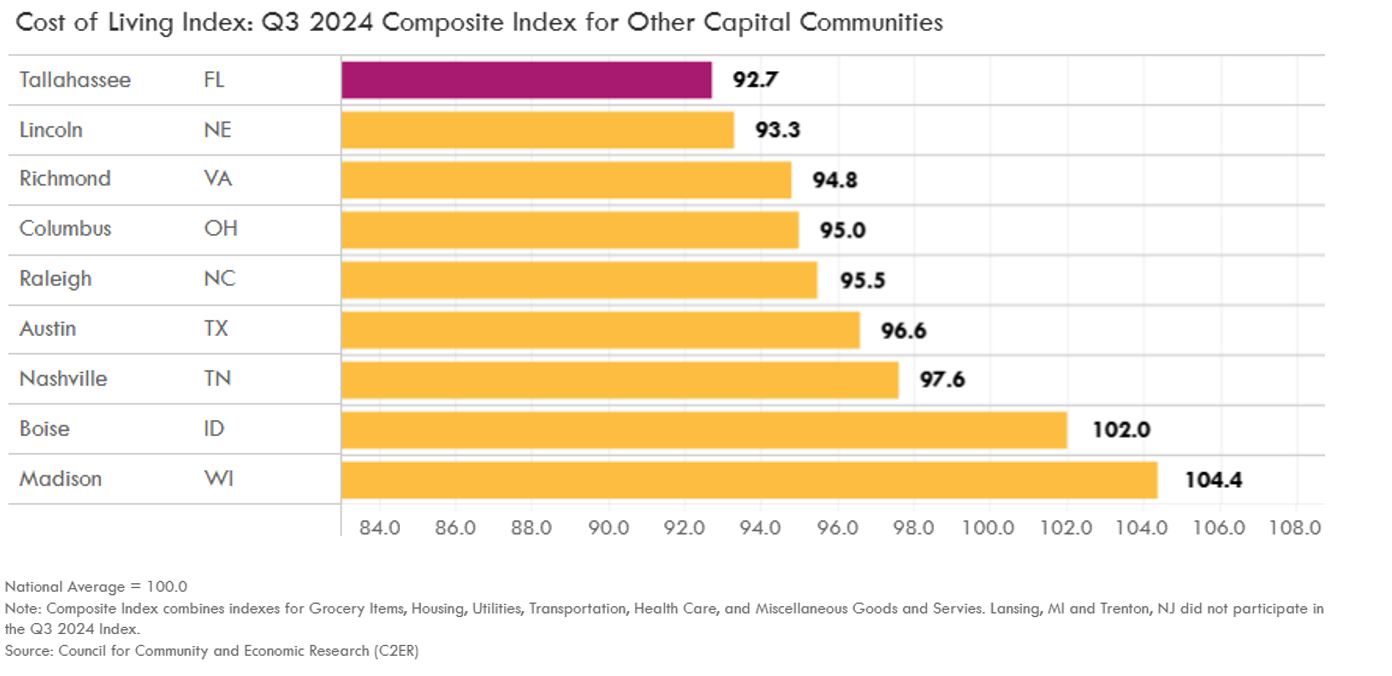
https://oevforbusiness.org/data-center/interactive-data/cost-of-living-index/
Median family income rose again in 2024, from $81,400 to $91,700 year-over-year. This exceeds the State of Florida’s median income 2024 by 7% in 2024.
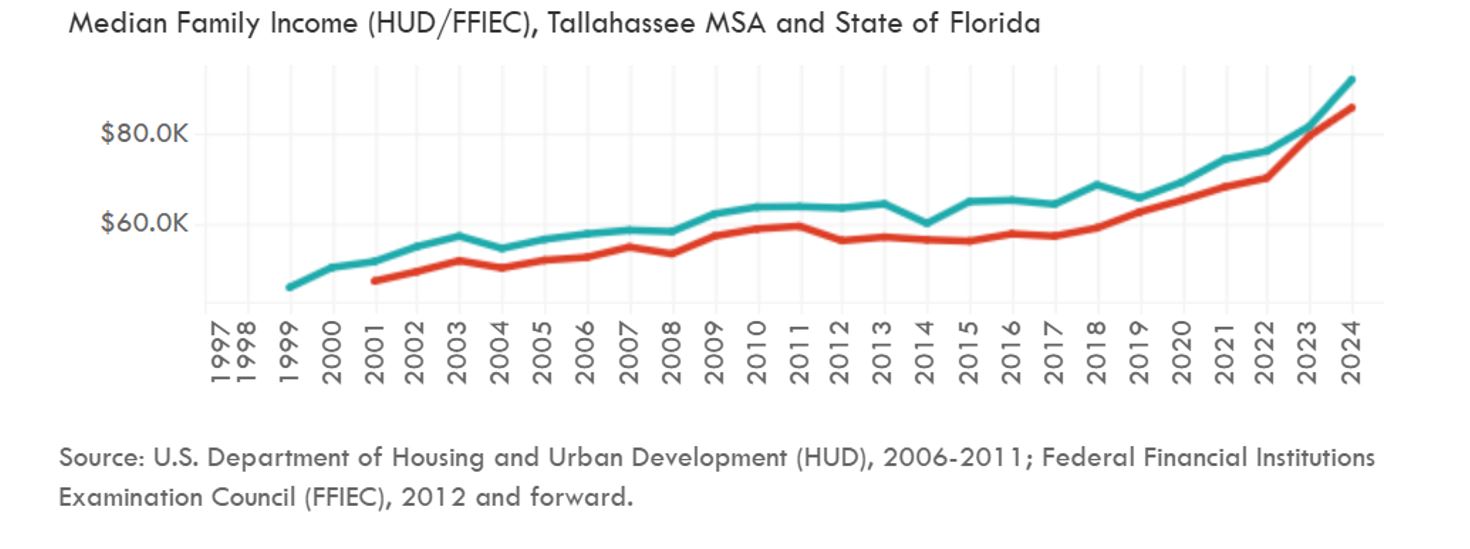
https://oevforbusiness.org/data-center/interactive-data/median-family-income
The average unemployment rates for the Tallahassee metro area generally fell from 2011 to 2019. In 2023, the average unemployment rate for the Tallahassee Metro Area was 3.1%, down from 4.4% in 2021 to 6.2% in 2020. This is compared to the unemployment rate in the US for the same period, from a high of 8.4% to 3.6%.
https://oevforbusiness.org/data-center/interactive-data/unemployment-rate-annual-average
The FY25 balanced budget allocates resources to priorities at the direction of the City Commission, enabling the City to continue as a national leader in public service delivery to accomplish the goals and initiatives outlined in the Five-Year Strategic Plan and to deliver results in public safety, affordable housing, infrastructure enhancement, and exceptional customer service. Key elements of the FY25 Operating and Capital Budgets include:
- Investing in public safety with highly skilled staff, technological advances, and collaboration via the Real Time Crime Center.
- Reducing costs while elevating the quality of services delivered to citizens through strong operational management and identification of efficiencies, including technology enhancements.
- Continuing as a leader in the delivery of public service by recognizing the efforts of the City’s workforce, including compensation sufficient to retain, attract, develop, and support skilled talent.
- Replenishing the Special Insurance Reserve Fund and general and enterprise fund reserves used for storm preparation, response, and restoration.
- Significant investments in infrastructure to ensure the continuity and resilience of essential services such as utilities, sidewalks, roads, and transportation. This includes capital improvement projects like the second Senior Center, the Southside Transit Center, the Public Safety Complex, the Fire Station at Lake Bradford Road, and numerous sidewalk and road projects. It also includes capital investments in utilities infrastructure of $154.1 million.
To achieve the City Commission’s priorities, the FY25 budget continues efforts to streamline operations, consolidate work groups, and utilize cutting-edge technology to improve efficiency and effectiveness. At the June 19 workshop, staff presented a proposed budget that included nearly $3 million in expense reductions. These reductions included aggressive fuel hedging strategies, consolidating work groups within and across departments, transitioning to cloud-supported systems, and organization efficiencies in the offices of the appointed officials. All of these efforts to reduce expenses have been done to maintain current output and service levels and have resulted in an FY25 balanced budget.
The City's priorities, as presented in the Strategic Plan, are shown below, and direct links to the Strategic Plan document are provided for more detail.
These principles guide budgetary planning. The City will continue prioritizing investment in targeted areas highlighted by the strategic plan and the City Commission.
1.4 Millage Rate
The millage rate is used to calculate ad valorem taxes (property taxes) due by each property owner. The rate is expressed as dollars per $1,000 of taxable property value.
The City of Tallahassee’s millage rate is 4.4200, a decrease of .0300 mills compared to the last fiscal year. The City’s millage rate of 4.4200 mills is among the lowest of the 20 largest cities in Florida. It is the third lowest of the 12 cities in the Municipal Cost Comparison, an annual study of costs of living and doing business in municipalities across Florida. The chosen cities share similarities to Tallahassee in population, range of services provided, and rate of taxable property. Below is Tallahassee compared with four of those cities, including Gainesville and Lakeland.
A low millage rate keeps the cost of homeownership affordable while still providing high-quality services.
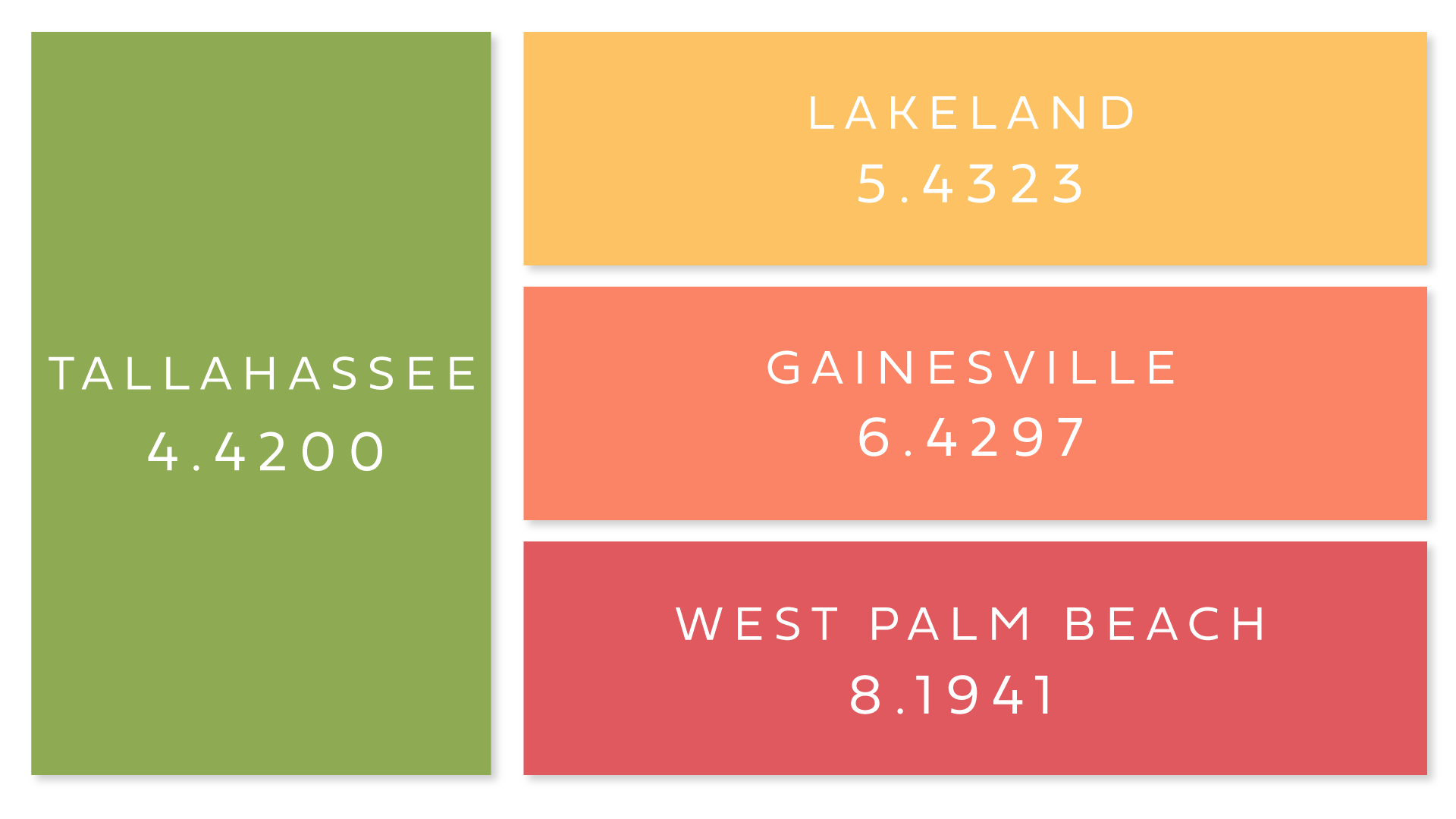
1.5 Municipal Cost Comparison
When measuring costs to citizens, the City compares itself to a group of eleven cities that share similar demographics, services provided, and square miles served. The Municipal Cost Comparison below contrasts what residential and commercial citizens pay for municipal services.
City utilities undergo regular fee studies to ensure that costs for services are recovered and paid for by those that benefit. The municipal cost comparison, however, demonstrates the competitiveness of rates compared to peer cities across the state. The City ranks as one of the most affordable to citizens year after year. Click on the images below for a further analysis of the Municipal Cost Comparison.
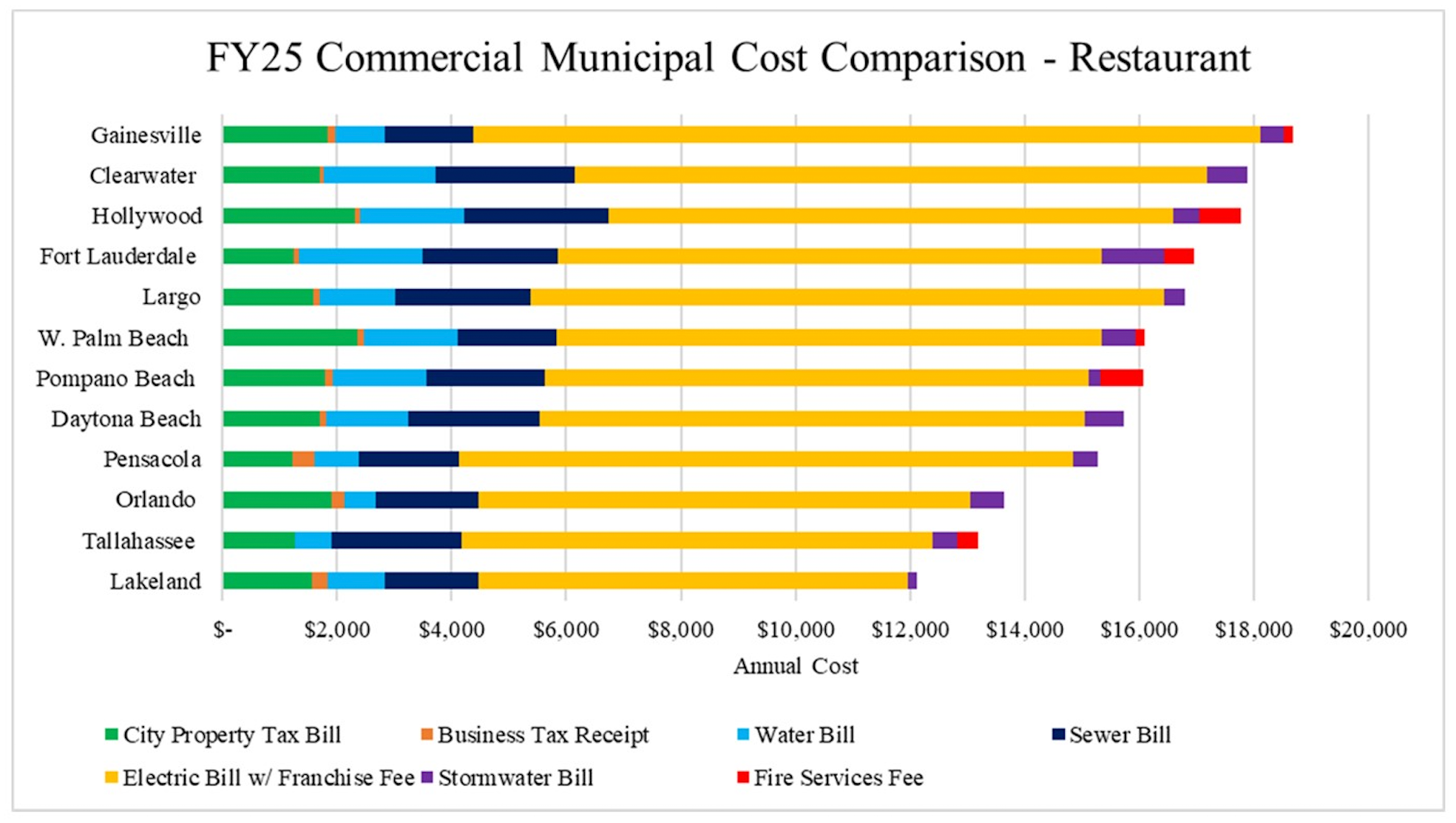
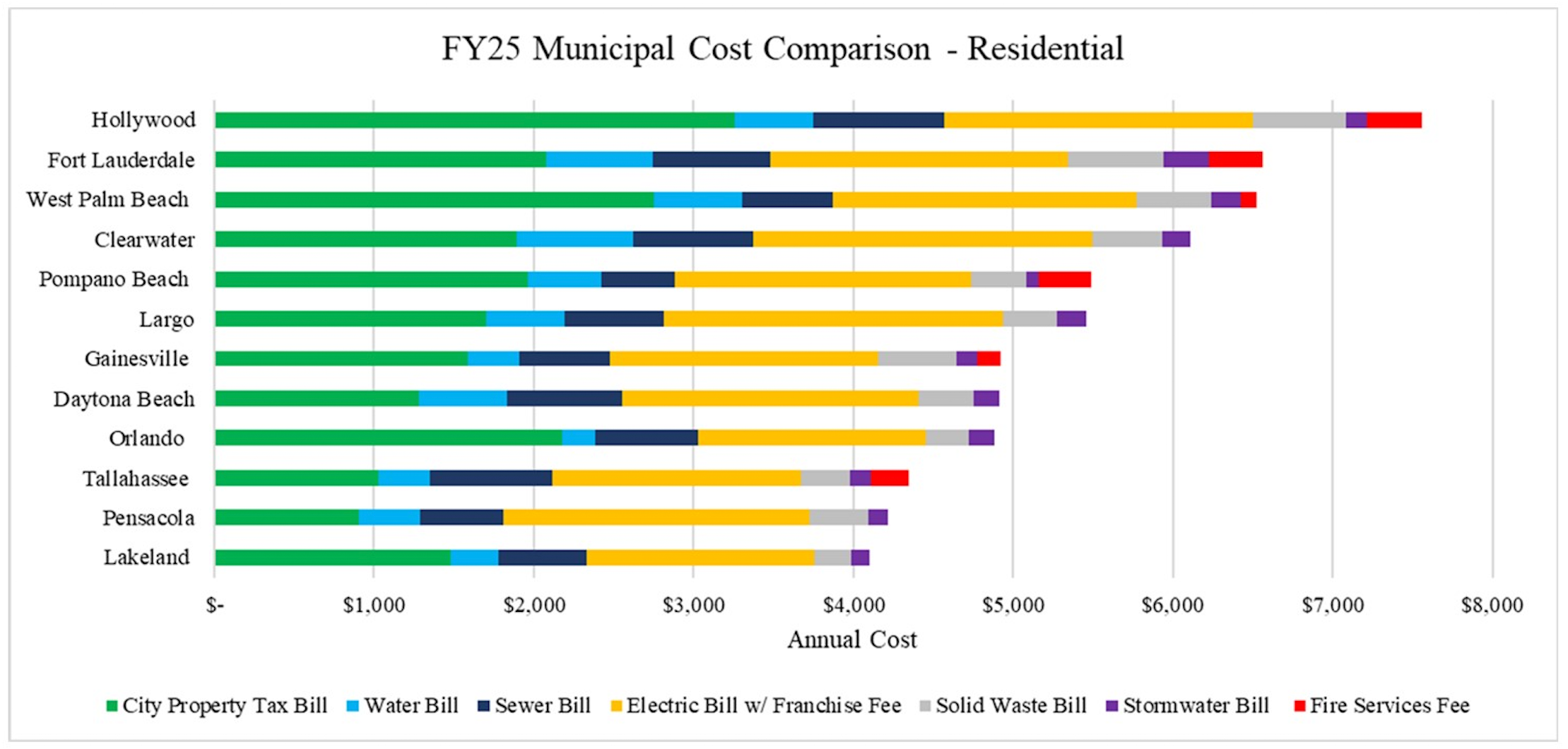
1.6 Population & Other Community Statistics
Tallahassee experiences consistent population growth. The City plans for a continued increase of its services. When making infrastructure decisions, the organization considers not just today’s demands but also tomorrow’s needs.
To view other statistics and trends that formulate the budget and plans for the City, please click here to read the Supplemental Demographic and Economic Information section.
FY2025 BUDGET OVERVIEW 2.0
STRUCTURE, POLICY AND PROCESS
2.2 Fund Descriptions & Structures
A fund is an accounting entity that documents activities. Fund accounting prioritizes accountability over profitability. Separate funds ensure revenues are appropriately related to expenditures.
Government funds include core city services funded by property taxes, utility transfers, public service taxes, state revenue sharing, and other general revenues. Enterprise funds are self-supported by user fees and charges. These operate similarly to private businesses.
Below are summaries of appropriated funds.
General Fund
This fund supports many core city services, including police, parks and recreation, road maintenance, housing initiatives, economic development, land use, environmental regulation, and animal services. The general government also provides an operating subsidy to Star Metro, the City's transit system.
Fund Type
Government
Surplus
Per City Commission policy 224.5 (II)F, year-end surpluses, to the extent available and appropriable, will first be used to fund the Deficiencies Reserve until its target level is achieved. Surpluses above this level may be allocated to support the subsequent year’s operating budget, up to a maximum of five percent of general government expenditures, and to buy down debt-financed capital improvement projects.
General Fund Transfer
$6.2 million in new funding is budgeted to support projects in FY25.
Operating Reserve
The FY25 revenue budget does not include transfers from General Fund Operating Reserves.
Other
Deficiencies Reserve: If the subsequent fiscal year ends with an operating deficit due to unforeseen circumstances, up to 5% of FY24 year-end surpluses will be available from the Deficiencies reserve as needed.
Fleet Reserve: The FY24 contribution is $2.3 million
RR&I: Undesignated balance set at a maximum of 3% of general government capital projects.
The Growth Management Department is responsible for enforcing the City’s building codes through the review of building plans, permitting, and the inspection process. Specific actions include ensuring that planned construction complies with applicable codes, authorizing utility connections and issuing certificates of occupancy, providing centralized intake and coordination of all permit applications, administering contractor licensing regulations, and enforcing the rooming house ordinance.
Fund Type
Enterprise
Surplus
To the extent available and appropriable, all year-end surpluses will be retained within the fund and made available for operating expenses and capital projects.
Operating Reserve
The FY25 revenue budget does not include transfers from operating reserves.
Other
Not applicable.
Established in 1902, the Tallahassee Fire Department (TFD) is a municipal fire department that provides fire suppression and emergency medical services in the City and the unincorporated areas of Leon County, Florida. The department protects lives, property, and the environment from hazardous conditions threatening our community. This mission is accomplished by providing prevention and protective services specific to the incident need.
Fund Type
Enterprise
Surplus
Retained for fire operating and capital costs.
General Fund Transfer
No transfer.
Operating Reserve
No reserve defined by policy.
Other
Not applicable.
The Electric Utility serves over 128,000 customers in a 221-square-mile service territory. It is the fourth-largest municipal electric utility in Florida and the 27th-largest of over 2,000 municipal systems in the United States. The utility comprises six significant divisions: Finance and Administration, Power Delivery, Energy Supply, System Operations, System Compliance, and System Integrated Planning. The Electric Utility develops a 10-year sales forecast annually to use in the annual budget process.
Fund Type
Enterprise
Surplus
Operating fund balance after General Fund transfer minus bond reserves used to fully fund the operating reserve, with the balance designated for electric system capital projects.
General Fund Transfer
The transfer is based on CPI. The transfer for FY24 is $38.1 million.
Operating Reserve
The operating reserve comprises four subcomponents, with the primary purpose of providing working capital. The working capital component is targeted to having a balance of 60 to 90 days of operating expenses. The other three components are fuel risk management, emergency reserve, and rate stabilization.
Other
RR&I: Transfer budgeted at a level equivalent to depreciation expense as provided in the Comprehensive Annual Financial Report (CAFR).
The City of Tallahassee's Natural Gas Utility has provided clean, safe, economical, and reliable natural gas to residents and businesses in a growing service area for over 60 years. The utility safely provides natural gas energy through 965 of miles of underground gas mains, which serve over 34,000 customers in the Leon, Gadsden, and Wakulla areas. The highly trained staff works to ensure the distribution system's integrity and dependability and assist customers with energy conservation and cost savings through natural gas use.
Fund Type
Enterprise
Surplus
Designated to fund the operating reserve fully and, after that, to fund gas system capital projects
General Fund Transfer
The transfer is based on CPI. The transfer for FY25 is $3.7 million.
Operating Reserve
Funded at 25% of the previous year’s General Fund transfer and used to meet General Fund transfer, if required.
Other
RR&I: Transfer budgeted at a level equivalent to depreciation expense as provided in the applicable rate study.
Approximately 88,000 service points are connected to the City’s water distribution network that provides potable water to essentially all developed areas in the City and certain contiguous county areas. More than 9 billion gallons are produced annually by an around-the-clock operation that utilizes 27 water production facilities, eight elevated storage tanks, 7,437 fire hydrants, and 1,247 miles of water distribution pipes.
Fund Type
Enterprise
Surplus
Designated to fund the operating reserve fully and, after that, to fund water system capital projects.
General Fund Transfer
The transfer is based on CPI. The transfer for FY25 is $4.4 million.
Operating Reserve
Funded at 25% of the previous year’s General Fund transfer and used to meet General Fund transfer, if required.
Other
RR&I: Transfer budgeted at a level equivalent to depreciation expense as provided in the Comprehensive Annual Financial Report (CAFR).
The City’s Wastewater Utility is responsible for collecting, treating, and recycling wastewater and for treating commercially pumped sewage. As part of the City’s commitment to protecting the environment, treatment processes utilized at the Thomas P. Smith (TPS) Advanced Water Reclamation Facility result in effluent that meets and exceeds regulatory requirements. On average, the wastewater system collects and treats more than 17.2 million gallons per day.
Fund Type
Enterprise
Surplus
Designated to fund the operating reserve fully and, after that, to fund sewer system capital projects.
General Fund Transfer
The transfer is based on CPI. The transfer for FY25 is $6.1 million.
Operating Reserve
Funded at 25% of the previous year’s General Fund transfer and used to meet General Fund transfer, if required.
Other
RR&I: Transfer budgeted at a level equivalent to depreciation expense as provided in the Comprehensive Annual Financial Report (CAFR).
The Aviation Fund supports all six Aviation Department divisions and services that support the Airport and its operations. The Airport Fund is self-supporting and requires no support from the general government.
Revenue sources for the Airport include airline charges, airport parking, rental car concessions, retail and dining concessions, and the rental of leased property. The key drivers are enplanements, deplanements, and aircraft operations. Total revenues have increased over the past four years, including a $1.2 million increase in revenue in FY24. The increase is primarily due to a return to pre-pandemic airport traffic, including increases in Rental Car and Parking Lot Revenues. Several capital projects are ongoing at the airport, including the International Processing Facility, Parking Lot Lighting Improvements, Runway 9-27 Rehabilitation, Main Terminal Central Chiller Replacement, and Taxiway Bravo Rehabilitation.
Fund Type
Enterprise
Surplus
Retained within the fund and allocated according to the airline use agreement.
General Fund Transfer
No transfer to General Fund. Full recovery of cost.
Operating Reserve
A minimum of 1/12th of the Airport's operating and maintenance budget is designated for unanticipated non-recurring expenditures.
Other
RR&I: Not applicable.
StarMetro, the public transit service for the City of Tallahassee, operates fourteen weekday cross-town routes, including university service for Florida State University (FSU) and student ridership programs for Florida Agricultural & Mechanical University (FAMU), Tallahassee Community College (TCC) and K-12 students in Leon County.
The Fixed Route and Para-transit department provides accessible, equitable, and efficient transit services to visitors and citizens of Leon County and Tallahassee. Transit services are provided 363 days a year and assist in emergencies as needed.
Fund Type
Enterprise
Surplus
Retained within the fund for operating expenses and capital projects.
General Fund Transfer
Transfers in from the General Fund support StarMetro operational deficits, when necessary.
Operating Reserve
No Reserve.
Other
RR&I: Not applicable.
The Solid Waste Fund provides garbage, recyclable materials, bulk, and yard waste collection for all residential customers citywide, and garbage and recyclable materials collections for commercial customers. Currently, the City serves 51,572 residential, 25,308 commercial, and 1,835 commercial recycling service points. Services include:
- residential bi-weekly curbside collection of bulky items, yard waste, electronics, and white goods,
- dumpster services for commercial customers collected by front-end loading trucks at night, up to six times per week,
- commercial container service with roll-off or hook trucks up to six times per week,
- commercial recycling up to five days per week, as well as other enhanced services, and,
- dead animal removal.
Fund Type
Enterprise
Surplus
Retained for rate stabilization reserve.
General Fund Transfer
Each year the transfer is increased by CPI. The transfer for FY25 is $2.5 million..
Operating Reserve
No Reserve.
Other
RR&I: Not applicable.
The Stormwater Fund manages and develops infrastructure for drainage, flood prevention, and retention of stormwater run-off to prevent pollutants from entering the aquifer. Work includes capital project oversight, maintenance of drainage infrastructure such as retention ponds and drainage outfalls, monitoring of lakes and groundwater, and raising public awareness of the environmental impacts of pollution, such as the Think About Personal Pollution (TAPP) program. The Stormwater Utility serves 77,000 residential customers and 6,000 non-residential customers through operational activities and the design and construction of drainage facilities infrastructure. This includes the maintenance of drainage facilities and ponds throughout the City.
Fund Type
Enterprise
Surplus
Retained for stormwater system capital projects.
General Fund Transfer
The transfer to the General Fund represents administrative cost sharing only.
Operating Reserve
No Reserve.
Other
RR&I: Maximum of 5% of capital projects funding sources, with a minimum level of 3%..
The Golf Fund supports Hilaman Golf Course, which offers a community-wide golf experience through daily rounds, driving range use, charity events, tournaments, and more. Hilaman also has a Pro Shop, restaurant, and outdoor deck area that provide a well-rounded experience. The course is open daily from 7:30 a.m. until dark, and course operations are led by a General Manager and two full-time staff members: a foreman and a course maintenance supervisor. In addition, Hilaman has over two dozen part-time employees who help with various day-to-day operations.
Fund Type
Enterprise
Surplus
Retained for Golf operating and capital costs.
General Fund Transfer
No transfer.
Operating Reserve
No reserve.
Other
Not applicable.
View full schedule of major and nonmajor funds.
View matrix of the relationship between departments and funds.
2.3 Basis of Budgeting
Budgets for general operation funds (General, StarMetro, and Golf Course Funds) are prepared on a modified accrual basis. The obligations for these funds (i.e., outstanding purchase orders) are considered expenditures, but revenues are recognized only when they are measurable and available. At the end of the fiscal year, open encumbrances are reported as reservations of fund balance. The operating budget does not include expenses for depreciation.
The budgets for the City’s utilities (Electric and Underground) and other enterprise funds (Aviation, Building Inspection, Solid Waste, Fire, and Cemeteries) are budgeted on a full accrual basis. Expenditures are recognized when a commitment is made (e.g., through a purchase order). Revenues are also recognized when they are obligated to the City, such as when utilities distribute bills.
The basis of budgeting is the same as the basis of accounting used in audited financial statements. Budget and accounting procedures are subject to modifications to comply with generally accepted accounting principles (GAAP) and the Governmental Accounting Standards Board (GASB) standards.
2.4 Internal Policies
There are several statutory requirements, internal policies, and other provisions that direct the development of the budget and its implementation throughout the year. The City of Tallahassee Commission Policy Manual contains policies adopted by City Commission that provides to management broad general direction to achieve specific goals and objectives. To review the City Commission Policies, click here.
Florida Statutes, Chapter 166 – This statute authorizes municipalities to levy taxes, issue licenses, and set user fees to raise money necessary to conduct municipal government activities. This chapter also requires that local governments adopt a balanced budget. The tentative balanced budget must be posted on the municipality’s official website at least 2
days before the budget hearing, held pursuant to s. 200.065 or other law, to consider such budget. The final adopted balanced budget must be posted on the municipality’s official website within 30 days after adoption.
Comprehensive Plan – The Tallahassee-Leon County 2010 Comprehensive Plan was originally adopted by ordinance in FY 1990 and is updated with biannual amendment cycles. The Plan includes capital improvements, transportation, historic preservation, utilities, recreation, and other elements which provide a framework for allocating budget resources. The Capital Projects Summary consists of a listing of capital projects that address Comprehensive Plan initiatives by eliminating deficit levels of services or by maintaining existing levels of service.
Financing Policy, No. 224 Commission Policies – The financing policy establishes guidelines for the distribution of year-end surpluses, transfers from the utilities to the General Fund, types and amounts of operating reserves, and funding for capital projects from undesignated fund balance year-end revenues. The policy also provides for full recovery of cost for enterprise funds, limits non-utility fee increases to a maximum of 20% per year unless otherwise approved by the City Commission, and allows discount fees for recreational programs for youth, seniors, and disabled citizens. The “Finance Policy Summary” chart shows the policy's requirements as applied to each fund.
Risk Management Policy/Self-Insurance, No. 214 Commission Policies – This policy creates an internal service fund for payment of anticipated claims and judgments for coverage areas defined in the policy. In addition, a special Insurance Reserve Fund is established and funded to meet unanticipated losses from catastrophic events or claims in excess of the Risk Management Fund. This reserve is set at 150% of the average claims for the past five years or $3,000,000, whichever is greater.
Capital Project Management, No. 218 Commission Policies – This policy provides for the preparation of an annual capital budget and a five-year capital improvement plan. The policy also defines the roles and responsibilities of city departments and management regarding contracts, supplemental appropriations, expenditures, and project administration. The use of capital project overhead charges as an operating budget funding source also is established by this policy.
Local Option Sales Tax Management, No. 232 Commission Policies – This policy establishes the authority to provide advance funding for local Florida Department of Transportation (FDOT) projects for any project or project phase included in the FDOT five-year work plan. It allows for advance funding without an agreement for repayment after conducting a public hearing. The policy also authorizes using short-term debt to cover cash flow shortages that may result from this practice.
Debt Management Policy, No. 238 Commission Policies – The debt management policy, along with an analysis of the city’s compliance with the policy, is included in the capital budget summary and the capital improvement plan. Section 104 of the City Charter also specifies that general obligation debt will not exceed 20% of the assessed taxable valuation. Florida Statutes require that general obligation bonds be approved by referendum. The city currently does not have any general obligation bonds.
Vehicle Replacement Reserves – Funding for vehicle replacement is included annually in the capital budget. Vehicle replacement charges for a proportionate share of these costs are allocated based on equipment usage.
Bond Covenants – Before 1998, provisions of Bond Resolutions required that a minimum of 5% of prior year gross revenues be budgeted annually for Renewals, Replacements, and Improvements (RR&I) for system improvements in the utility systems. Covenants for the Energy System (electric and gas) bonds issued after 1998 do not specify an explicit amount or methodology but require a transfer to an RR&I fund.
Union Agreements – Currently, unions represent 634 authorized positions. A total of 356 positions are subject to terms and conditions of the collective bargaining agreement with the Big Bend Chapter of the Florida Police Benevolent Association, Inc. (PBA), and 278 positions are subject to terms and conditions of the collective bargaining agreement with the International Association of Firefighters (IAFF). Union agreements are generally negotiated every three years. FY23 is the last year of the current contract for all bargaining units.
Utility Rate Studies – Rate studies are prepared for each utility enterprise operation (electric and underground utilities) every three to five years on a rotating basis. Revenue projections are prepared using historical weather patterns and other growth factors.
Assessment and Fee Reviews – Fees and assessments are periodically reviewed to ensure recovery of costs to provide certain services. Rates for electricity, underground utilities, and solid waste are set by ordinances that provide for annual increases based on the CPI.
2.6 Budget Process
The budget process involves collaboration and coordination among city departments, Resource Management, executive leadership, the City Commission, and the citizens of Tallahassee. It results in annual operating budgets, capital budgets, and a five-year financial and capital improvement plan for the General Fund and enterprise funds. While the fiscal year begins on October 1st, the budget is a continuous cycle.

The City holds several budget workshops throughout the year. These serve the dual purpose of updating for the current fiscal year and the next budget cycle. Workshops are less formal city commission meetings that do not include a litany of items for the commissioners to address. Instead, the workshop allows for a focused discussion on the topic.
At the first quarter workshop, Resource Management reports on the early status of its funds to the Commission for the current budget cycle. It also presents some initial assumptions to work toward for the next one. This includes proposing an initial millage rate and employee raises, benefits, and other items.
At the second quarter workshop, assumptions are reaffirmed, and priorities are addressed. Issues with the current year’s funding can be addressed while taking a stronger look at the upcoming year.
Resource Management presents a proposed budget for the following fiscal year at the third quarter workshop. These include most of the capital projects, priorities, and changes. Any significant issues for the current budget year are also addressed at this workshop.
The City maintains a “hold the line” philosophy when budgeting for departments’ operating costs. Budgets for things such as office supplies or contracts are not increased every year. Without automatic increases in budgets, staff innovate for cost savings annually. Departments evaluate procedures to be more efficient.
Hold the Line counters a classic budgeting issue known as “use it or lose it.” In older budgeting techniques, departments are incentivized to spend their budget entirely and use their resource depletion to justify maintaining their budget levels. Sometimes the spending would persuade for even higher budgets the following year. With Hold the Line, Resource Management assures departments that their budget levels are safe. This approach leads to less spending overall as departments do not spend money merely to defend their allocations.
At the 1st quarter budget workshop, staff presents initial assumptions to the City Commission for the next budget year. These include two major items: millage rate and staff pay raises.
For the City to be a leader in public service, it must recruit, train, and retain the best people. The City has a history of regular increases for staff ranging from two to three percent. This accommodates the cost of living increases, but the commitment can attract the best employees to the organization.
Departments are responsible for developing their respective budget requests with support from Resource Management. City Commission budget workshops are held throughout the year to discuss policy issues and the long-term ramifications of budgetary decisions. The City Commission adopts a tentative millage rate for assessing ad valorem taxes in early July, as state statutes require. The final budget and the millage rate are adopted by resolution during the month of September, following two statutorily required public hearings.
The City’s budget is appropriated at the fund level. Revenues are budgeted at the fund level only, while Department expense budgets are contained within one or more cost centers. There are currently nearly two hundred cost centers across all departments.
Budgetary control is maintained at the department level, with Resource Management providing support. In accordance with the city’s budget transfer policy, departments can amend budgets in various ways depending on the type of transfer being considered.
Any budgetary amendment within the department’s appropriated budget and within the same fund can be authorized by the City Manager. Transfers between departments that cross funds or increase appropriations are made at the request of the City Manager and must be approved by the City Commission.
Budgetary amendments between divisions and within the same fund may be initiated at the department head's discretion, except for transfers affecting specific categories such as personnel. Requests for amendments to the line item exceptions are reviewed by Financial Management and approved by the City Manager or respective appointed official for transfers affecting the offices of the City Attorney, Inspector General, or City Treasurer-Clerk.
Since implementing the PeopleSoft financial system, budgetary control has moved from the line-item level to the major budget category. In classic line-item budgeting, departments cannot spend more than a certain amount on very specific categories. This tended to limit flexibility, and governments could not adapt to problems that arose throughout the year. Now, departments may over-expend line items provided balances are available in the respective major budget category. This allows for greater managerial flexibility. Department heads can respond to citizens’ needs without dense bureaucratic processes.
FY2025 BUDGET OVERVIEW 3.0
FINANCIAL SUMMARIES
Five-Year Fund Proformas – Revenues and Expenses by Fund
By clicking on the fund titles below, a five-year proforma of revenues and expenditures will be displayed for each. The proforma includes the budget for the prior year, FY24, the adopted budget for FY25, and projections for the remaining years, FY26 – FY29. The five-year forecast is a means of facilitating long-range and financial planning. Below each proforma is a summary of FY25 budget highlights and a link to see an additional view of the fund in OpenGov.

See additional views of FY25 budget in OpenGov
See additional detail of the Five-Year Fund Pro Formas.
Estimated revenues and expenditures for FY25-FY29 reflect revenue projections and current expenditure levels. The latter years of the pro forma indicate how expected trends applied to current estimates will shape future budget planning.
FY25
The FY25 balanced budget allocates resources to priorities at the direction of the City Commission, enabling the City to continue as a national leader in public service delivery to accomplish the goals and initiatives outlined in the Five-Year Strategic Plan and to deliver results in public safety, affordable housing, infrastructure enhancement, and exceptional customer service. Key elements of the FY25 General Fund Budget are:
- Investing in public safety with highly skilled staff, technological advances, and collaboration via the Real Time Crime Center.
- Reducing costs while elevating the quality of services delivered to citizens through strong operational management and identification of efficiencies, including technology enhancements.
- Continuing as a leader in the delivery of public service by recognizing the efforts of the City’s workforce, including compensation sufficient to retain, attract, develop, and support skilled talent.
- Replenishing the Special Insurance Reserve Fund and general fund reserves used for storm preparation, response, and restoration.
FY26-29
Future revenue projections are conservative based on prior trends. As the annual budget is developed, estimates are updated closer to budget approval. Creating new options for revenue generation is limited by statute, and existing, significant revenue sources are sensitive to unforeseen economic impacts. FY25 revenues reflect the reduction of $6.7 million as the last of the ARPA grant is fully expended in 2024.
Personnel costs for future years reflect a 3% growth through FY28. However, the estimated increase would be adjusted if inflation and tight labor market conditions extend beyond FY25.
Operating costs from FY25 to FY29 are escalated by 2.8% overall.
Transfer estimates include debt service, insurance reserve reimbursement, operating project transfers, and the annual transfer for capital projects. Debt Service transfers from FY25 through FY29 reflect a $2.3 million increase; however, estimates will evolve as the plans for the timing of future borrowing evolve.
Estimates for FY25-FY29 do not include estimated increases in the number of positions in the fund—departments review service needs and staff levels during the annual budget development process.
The General Fund for FY25 totals $210 million and includes the Tallahassee Police Department, Parks & Recreation, Public Infrastructure (roads and street construction and maintenance), Community Housing and Human Services, and other non-utility services. The fund also contributes to StarMetro and the Consolidated Dispatch Agency, transfers the ad valorem share due to the community redevelopment agencies, and transfers funding for capital projects and debt service.

See additional views of FY25 budget in OpenGov
See additional detail of the Five-Year Fund Pro Formas.
Estimated revenues and expenditures for FY25-FY29 generally reflect revenue projections and current expenditure levels escalated by a CPI factor and indicate how expected trends applied to current estimates will shape future budget planning.
Budget Highlights
FY25
Building Inspection will continue to provide services at the level that demand requires and ensure full-cost recovery of costs. Per the Commission-adopted Resolution in 2022, Building Inspection fees will increase consistent with the Consumer Price Index (CPI).
FY26-29
Highly trained staff who are qualified and hold the necessary certifications are vital to providing a high level of service. Strategies for the future include maintaining excellence through training and credentialing of staff and managing staff levels to meet changing demands for services. The demand for and efficiency of online access to permitting services and information will require additional investment in new technology, including the potential implementation of services that can assist in expediting the permit review and approval process.
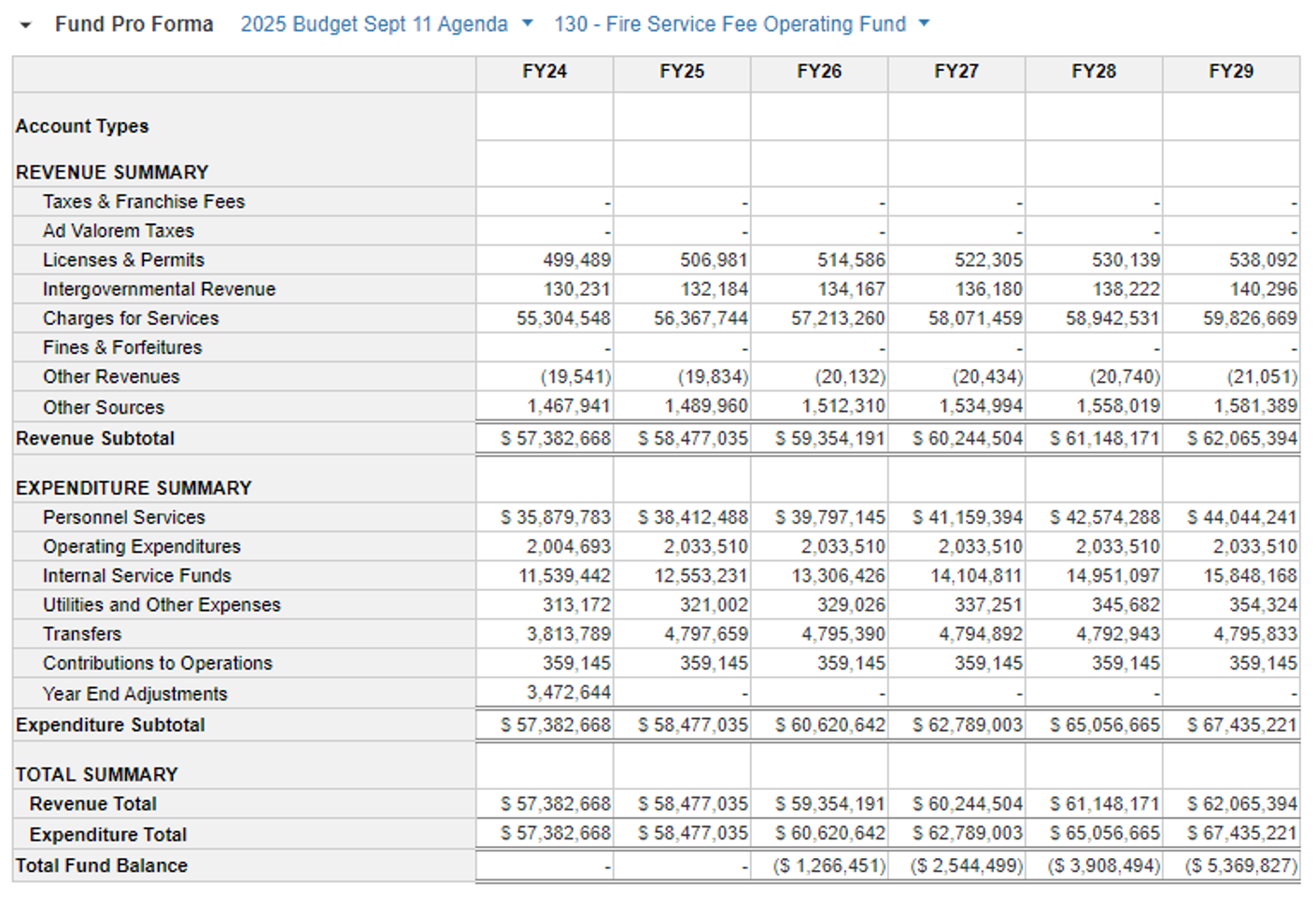
See additional views of FY25 budget in OpenGov
See additional detail of the Five-Year Fund Pro Formas.
Estimated revenues and expenditures for FY25-FY29 generally reflect revenue projections and current expenditure levels escalated by a CPI factor and indicate how expected trends applied to current estimates will shape future budget planning.
Budget Highlights
FY25
- The Tallahassee Fire Department added 12 new positions in preparation for the opening of Fire Station 17 and the expansion of Fire Station 15.
- A new three-year collective bargaining agreement between the City and the International Association of Fire Fighters was approved beginning in FY25. The terms of this agreement will affect personnel costs for future years.
FY26-29
- Personnel costs, equipment, and debt service for the upcoming Fire Station 17 are budgeted.
- An additional 24 FTEs are planned to support the expansion of Fire Station 17 and Fire Station 15.
- The additional costs associated with the current CBA contract will require an early review and a potential increase of the Fire Service Fee to accommodate these changes.
The Tallahassee Fire Department (TFD) provides the City of Tallahassee and Leon County with quality fire suppression; specialized hazardous material response; emergency management; facilities security; focused urban search and rescue; dedicated technical rescue; superior vehicle extrication; high-quality emergency medical care; fire safety code compliance review and enforcement; and varied public education services. Beyond Leon County, the department also provides emergency response via mutual aid to communities in the surrounding area. Within TFD, Emergency Medical Technicians (EMTs) are trained in Basic Life Support (BLS) measures for trauma care, cardiac and stroke care, CPR, advanced first aid, childbirth, and basic medication administration. TFD's paramedics are ALS certified and responsible for managing the emergency medical scene according to protocol and directing operations inside the medical transport unit as it travels to the hospital.
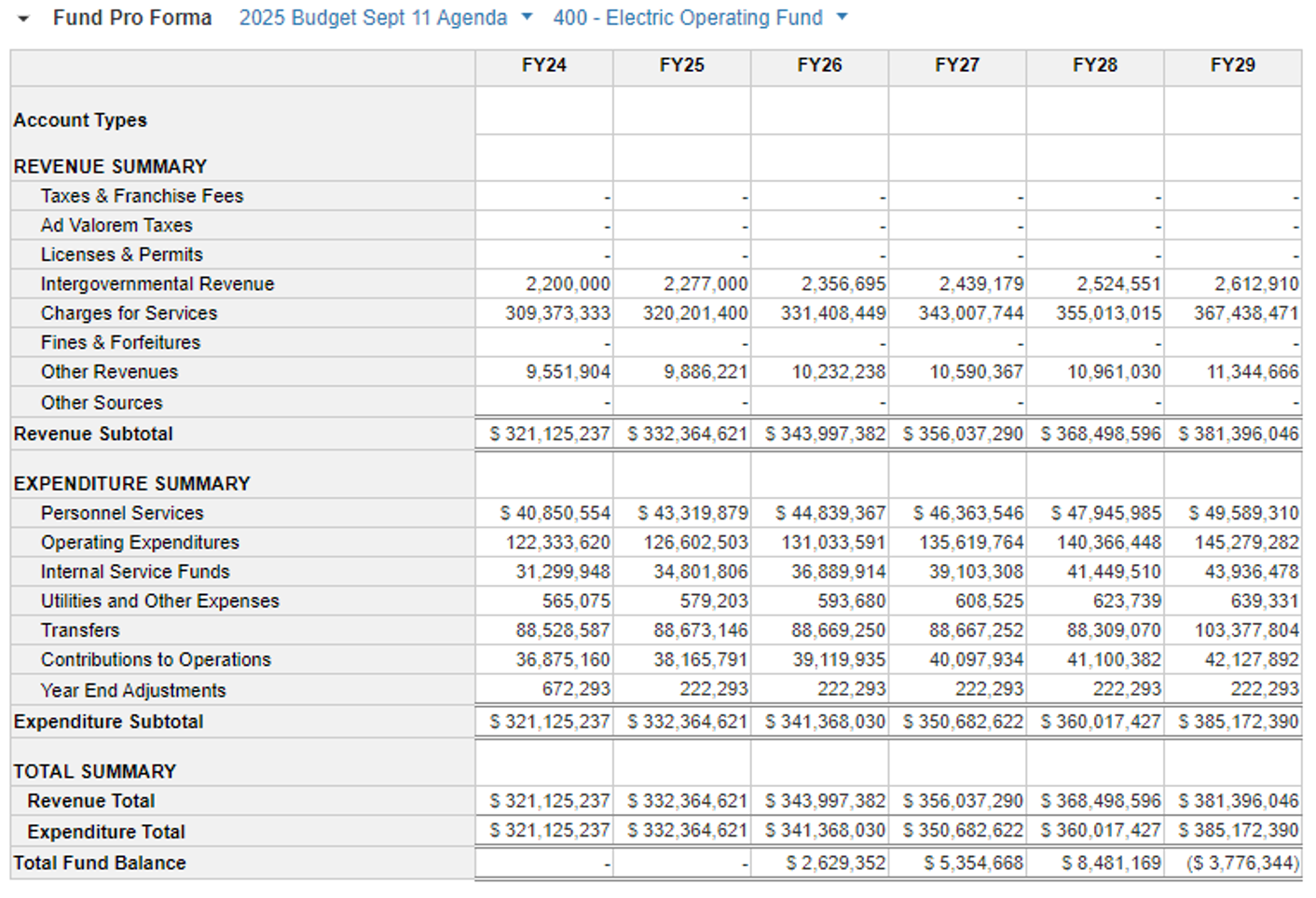
See additional views of FY25 budget in OpenGov
See additional detail of the Five-Year Fund Pro Formas.
Estimated revenues and expenditures for FY25-FY29 generally reflect revenue projections and current expenditure levels escalated by a CPI factor and indicate how expected trends applied to current estimates will shape future budget planning.
Budget Highlights
FY25
- The department will continue to explore expanding its’ solar generation capacity.
- The Electric Utility uses a 4-year rate study to guide the budgeting process.
FY26-29
- The Electric Utility continues to invest in the current electric grid by enhancing funding in tree trimming and systemwide switch inspection and replacement.
- There is also a focus on enhancing transmission reliability and import capability through additional bulk power system interconnections.
- The department continues to look to the future and implement the City’s Clean Energy Plan.
- Continued funding of pilot EV charging stations program and installation of new stations at key locations throughout the City.
The Electric Utility serves over 120,000 customers in a 221-square mile service territory. It is the fourth-largest municipal electric utility in Florida and the 27th-largest of over 2,000 municipal systems in the United States. The utility is comprised of six major divisions: Finance and Administration, Power Delivery, Energy Supply, System Operations, System Compliance, and System Integrated Planning. The Electric Utility develops a 10-year sales forecast annually to use in the annual budget process. This sales forecast is based on a variety of inputs, such as heating and cooling degree days, economic, and population growth, the weather being the most variable driver. As the year progresses, actual sales are used to guide the operational decisions of the utility.
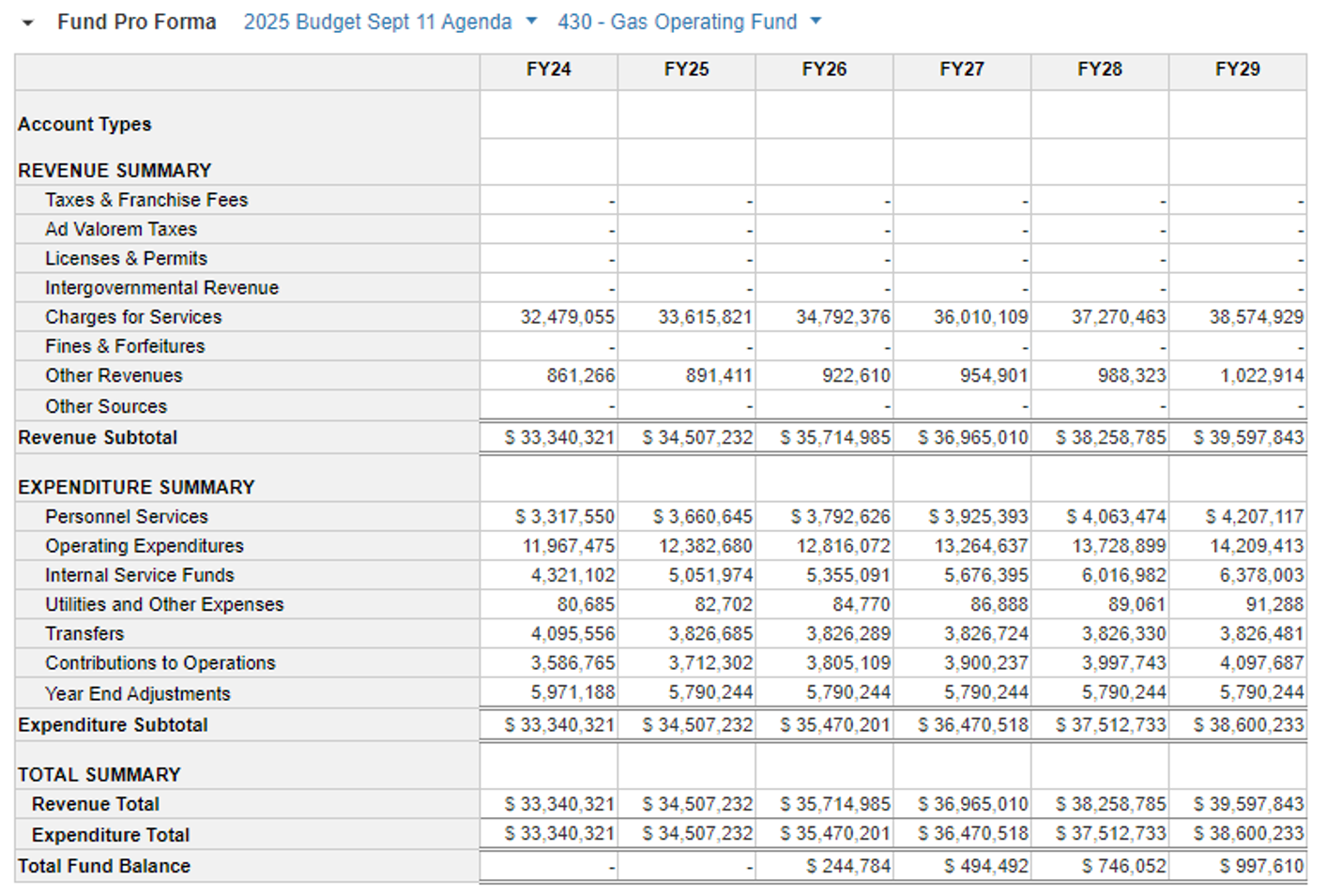
See additional views of FY25 budget in OpenGov
See additional detail of the Five-Year Fund Pro Formas.
Estimated revenues and expenditures for FY25-FY29 generally reflect revenue projections and current expenditure levels escalated by a CPI factor and indicate how expected trends applied to current estimates will shape future budget planning.
Budget Highlights
FY25
- The Gas utility continues to receive a high grade from its customers in satisfaction surveys. The Commission passed a new gas-hit-line fine in FY23, with most of the revenue to be used for community education programs. Education and outreach will help prevent future line damage, reducing costs and incidents involving the Utility’s infrastructure.
FY26-29
- The department continues to implement the City’s Clean Energy Plan.
- Further implementation of the Utility’s Methane Reduction Program.
The City of Tallahassee's Natural Gas Utility has provided clean, safe, economical and reliable natural gas to residents and businesses in a growing service area since 1956. The utility safely provides natural gas energy through 965 miles of underground gas mains that serve over 34,000 customers in the Leon, Gadsden, and Wakulla County areas. The highly trained staff works to ensure the integrity and dependability of the distribution system, and to assist customers with energy conservation and cost savings through natural gas use.
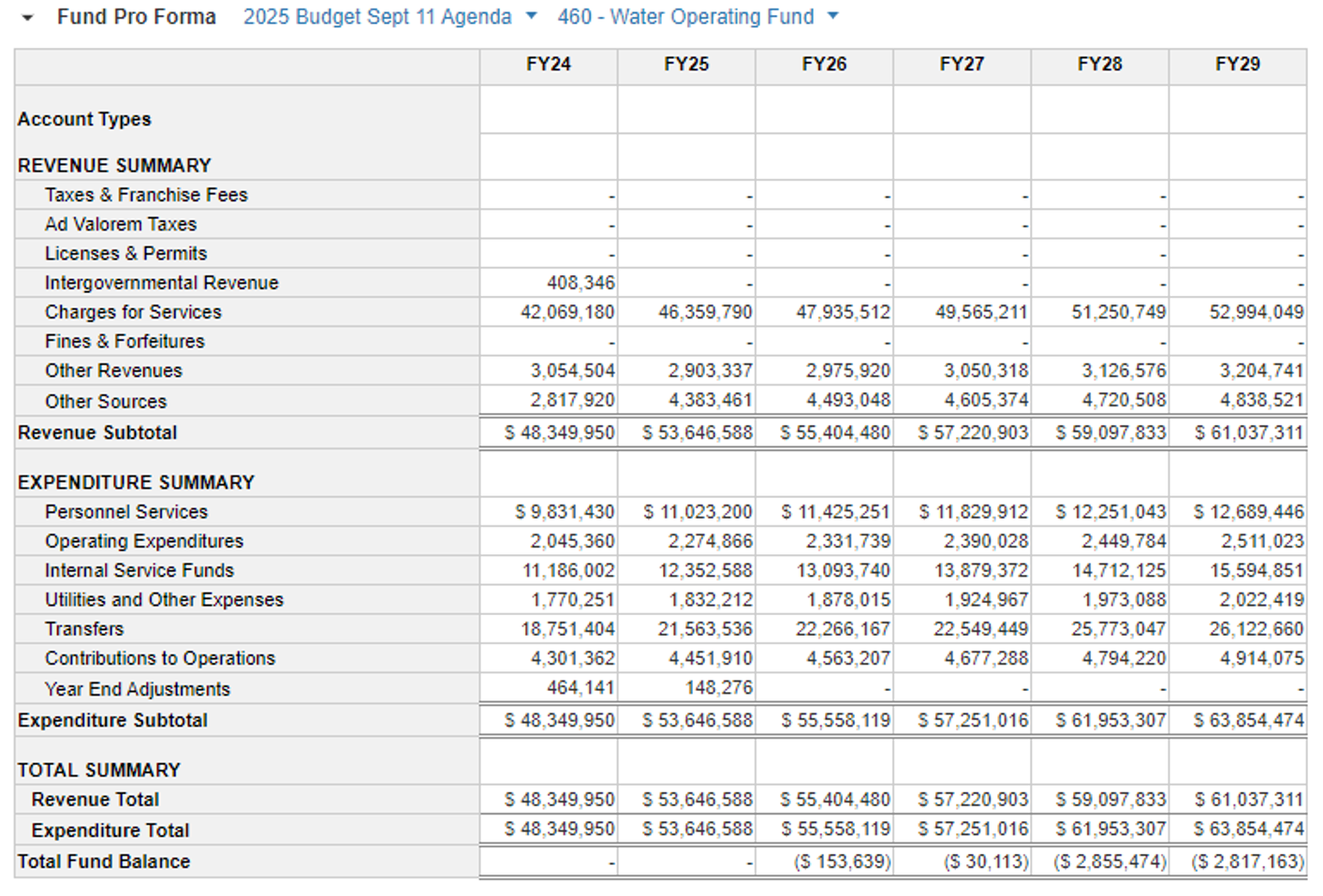
See additional views of FY25 budget in OpenGov
See additional detail of the Five-Year Fund Pro Formas.
Estimated revenues and expenditures for FY25-FY29 generally reflect revenue projections and current expenditure levels escalated by a CPI factor and indicate how expected trends applied to current estimates will shape future budget planning.
Budget Highlights
FY25
- Per City Ordinance, and consistent with the parameters of the most recent rate study, water rates were increased by a CPI factor of 3.5% on October 1, 2024. The total impact to the average residential utility bill (6,000 gallons) equates to $0.54 per month.
- In FY25, operating expenditures were analyzed and redistributed based on a historical three-year average to accurately reflect anticipated costs and incorporated budget assumptions based on the 2024 rate study, resulting in an overall 11.2.% increase.
- The Renewal, Replacement, and Improvement (RR&I) transfer for the capital improvements of Water infrastructure increased to $9.1 million, up from $6.8 million in FY24.
FY26-29
- Assumptions for rate revenues include modest customer growth of 1%, and CPI set at 3.5% for FY25 and 2.5% from FY26 through FY29.
- Operating expenses are estimated to increase by 2.5% through FY29.
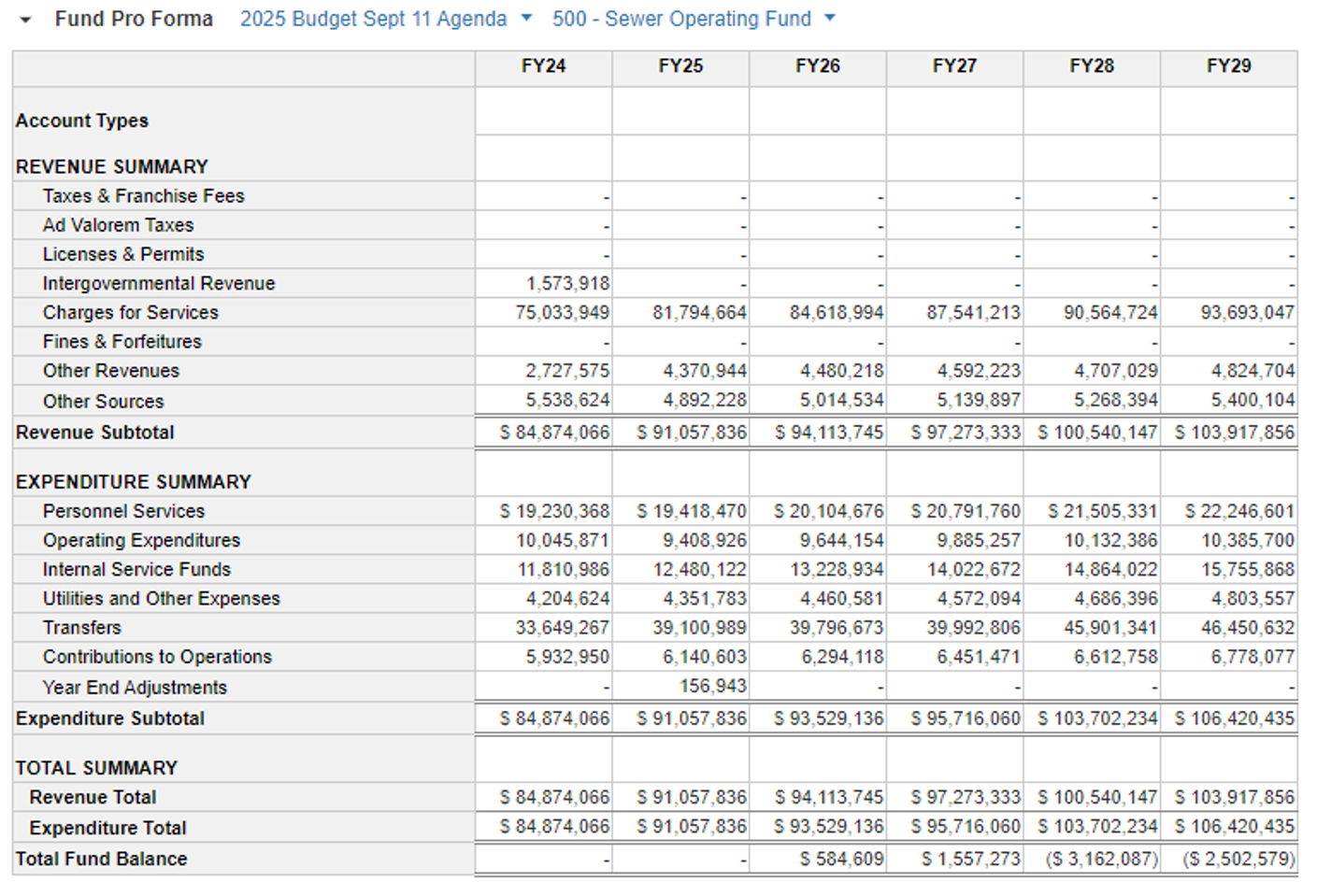
See additional views of FY25 budget in OpenGov
See additional detail of the Five-Year Fund Pro Formas.
Estimated revenues and expenditures for FY25-FY29 generally reflect revenue projections and current expenditure levels escalated by a CPI factor and indicate how expected trends applied to current estimates will shape future budget planning.
Budget Highlights
FY25
- Per City Ordinance, and consistent with the most recent rate study parameters, sewer rates were increased by a CPI factor of 3.5% on October 1, 2024. The total impact to the average residential utility bill (5,000 gallons) equates to $1.33 per month.
- In FY25, operating expenditures were analyzed and redistributed based on a historical three-year average to accurately reflect anticipated costs and incorporated budget assumptions based on the 2024 rate study, resulting in an overall 6.3% decrease.
- The Renewal, Replacement, and Improvement (RR&I) transfer for the capital improvements of wastewater infrastructure increased to $16.3 million, up from $12.3 million in FY24.
FY26-29
- Assumptions for rate revenues include modest customer growth of 1% and CPI set at 3.5% for FY25 and 2.5% from FY26 through FY29.
- Operating expenses are estimated to increase by 2.5% through FY29.
Commitment to capital investments includes a future borrowing in FY27 and a 3.7% average increase per year in the RR&I transfer through FY29.
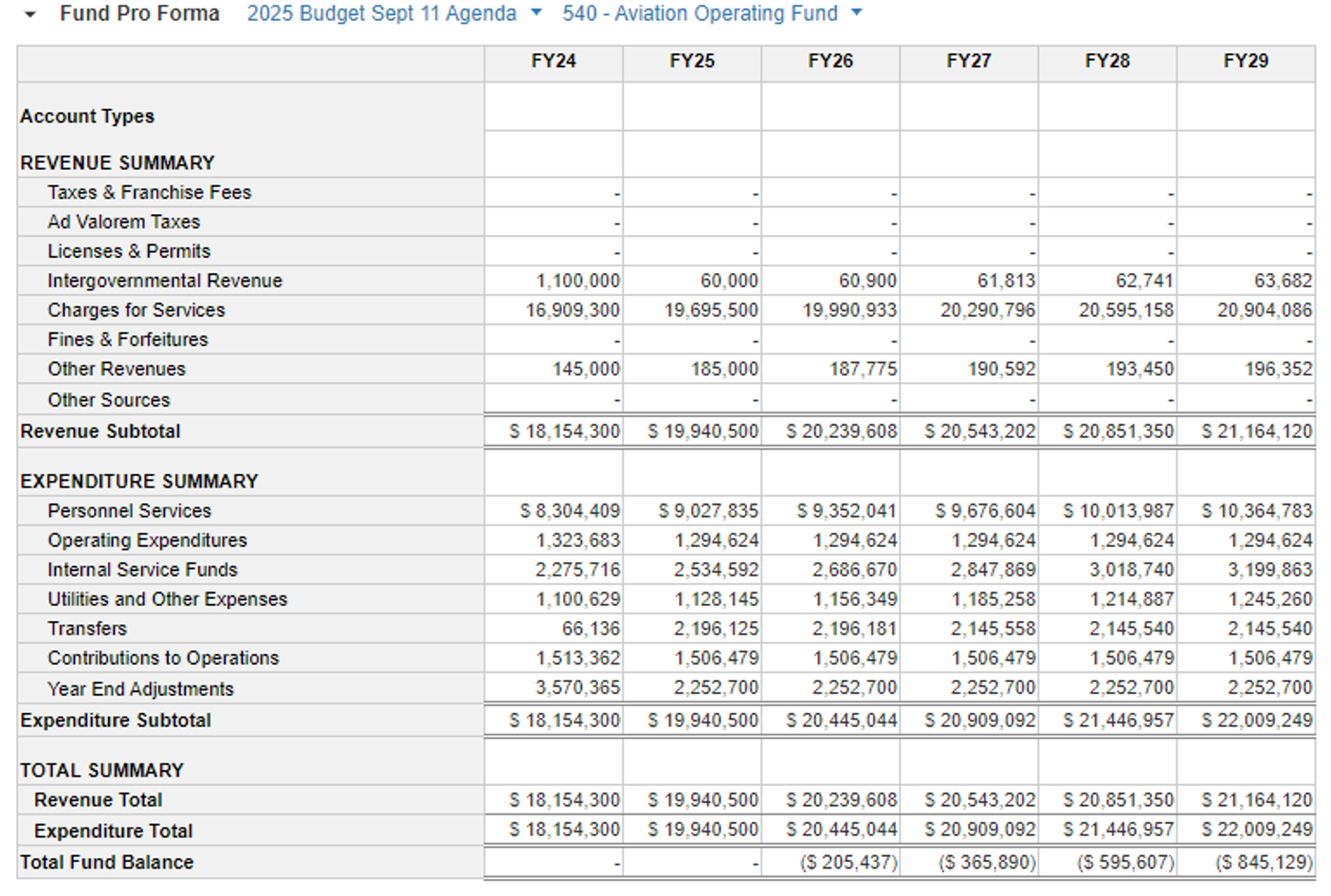
See additional views of FY25 budget in OpenGov
See additional detail of the Five-Year Fund Pro Formas.
Estimated revenues and expenditures for FY25-FY29 generally reflect revenue projections and current expenditure levels escalated by a CPI factor and indicate how expected trends applied to current estimates will shape future budget planning.
Budget Highlights
FY25
- Total revenues have increased over the past four years, including a $1.2 million increase in revenue this FY. The increase is primarily due to a return to pre-pandemic airport traffic, including increases in Rental Car and Parking Lot Revenues.
- The airport continues to receive considerable grant funding for capital projects.
- Expenses are set to increase by $2.0 million from FY23 to FY24 due to a rise in overall operational needs and RR&I investments.
- FTE employees have increased by 3 to 57 since FY19.
- Major Capital projects are ongoing at the airport, including the International Processing Facility, Parking Lot Lighting Improvements, and Taxiway Bravo Rehabilitation.
FY26-29
- Planning for future taxiway rehabilitation projects, along with additional facility capital improvements.
- The Tallahassee International Airport (TLH) is well on its way to establishing a new Foreign Trade Zone (FTZ) that will align with the opening of the International Processing Facility, currently slated for completion third quarter 2025. An FTZ is a secure, federally designated location in the United States that is considered to be outside of US Customs territory for tariff purposes. If approved by the U.S. Foreign-Trade Zones Board, TLH’s new Zone will span an eleven (11)-county Service Area between the I-75 corridor and Panama City. FTZs can provide numerous economic benefits and supply chain efficiencies to Zone users. TLH’s new Zone will bolster the region’s manufacturing sector, encourage international commerce, create jobs, stimulate the economy and increase the global competitiveness of the Northwest and North Central Florida Region.
- The Bipartisan Infrastructure Bill estimates the airport to receive roughly $16 million over the next five years (FY23 – FY27).
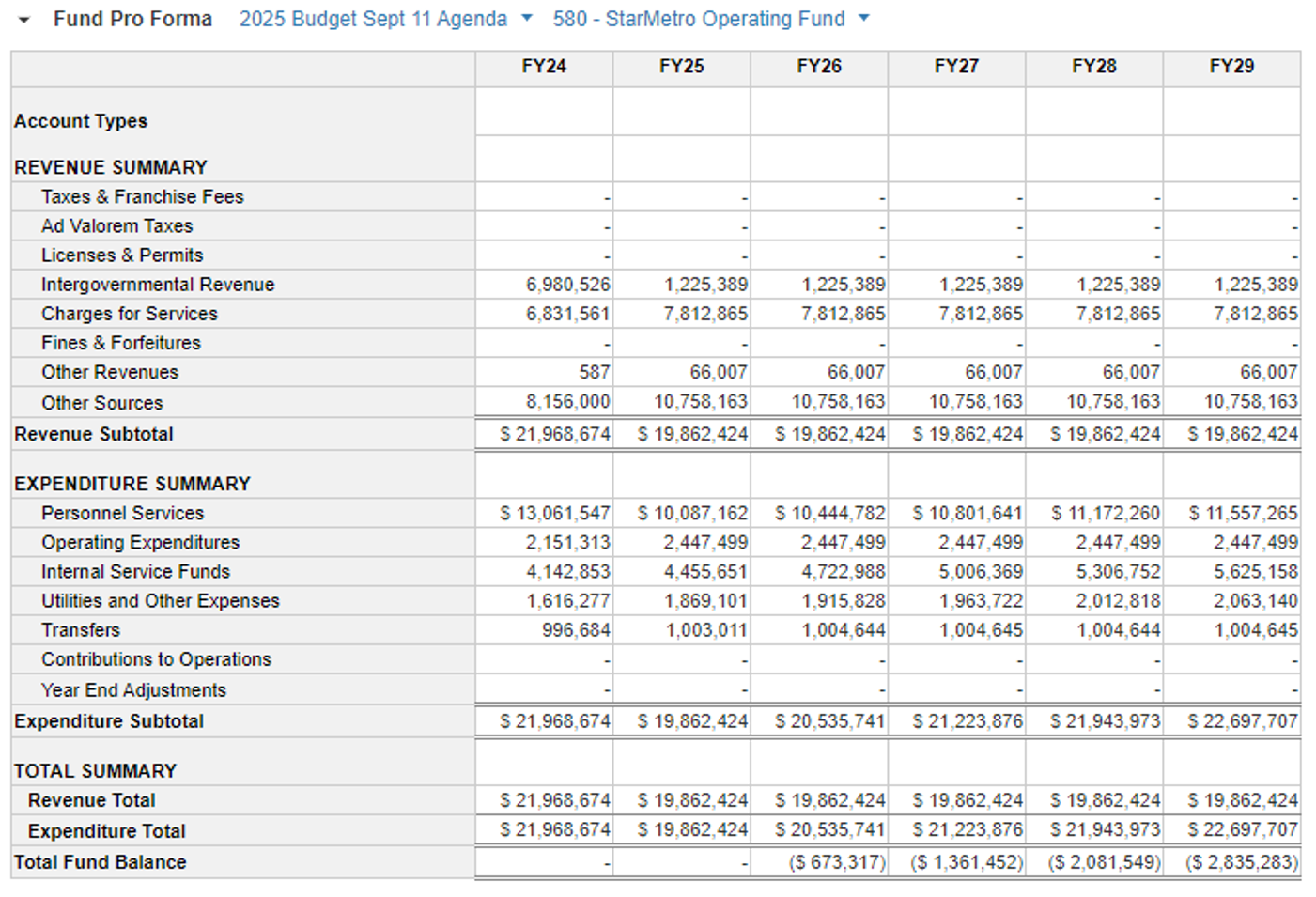
See additional views of FY25 budget in OpenGov
See additional detail of the Five-Year Fund Pro Formas.
Estimated revenues and expenditures for FY25-FY29 generally reflect revenue projections and current expenditure levels escalated by a CPI factor and indicate how expected trends applied to current estimates will shape future budget planning.
Budget Highlights
FY25
- The FY25 budget for the StarMetro Operating Fund totals $19.9 million. Grant revenue, formerly budgeted in the operating fund, is now budgeted separately in grant funds. The total estimate for grants in FY25 is $8.3 million from Federal, State, and local agencies.
- Charges for services are estimated to increase by $1 million in FY25. In FY24, FSU bus contract revenue made up $5.4 million of the projected $6.7 in service charges.
- The transfer from the General Fund increased to 7.2 million from the prior year’s $5 million, and revenue growth estimates were updated.
- StarMetro has 143.50 full-time equivalent (FTE) and 54 temporary employees.
FY26-29
- Future budget projections assume modest growth in revenues over the next five years. Efficiencies and strategies in FY24 focused on monitoring overtime and managing vacancies to keep costs low. Dial-a-Ride expenditures have increased in recent years; however, ridership analysis has allowed for better routing of customers to services best suited to their needs. This allows for a more efficient use of resources and lower costs for paratransit in FY25.
- The department will continue to leverage grant funds and work with Fleet Management to purchase electric buses. The target is to convert to electric buses by 2035.
- StarMetro received $20 million in grant awards to construct the South Side Transit Center (SSTC), with the construction phase expected to start in FY25. Grants for the project include $15 million from the US Department of Transportation, $1 million from the State Legislature, and $1 million from Blueprint. The City’s match is $3 million.
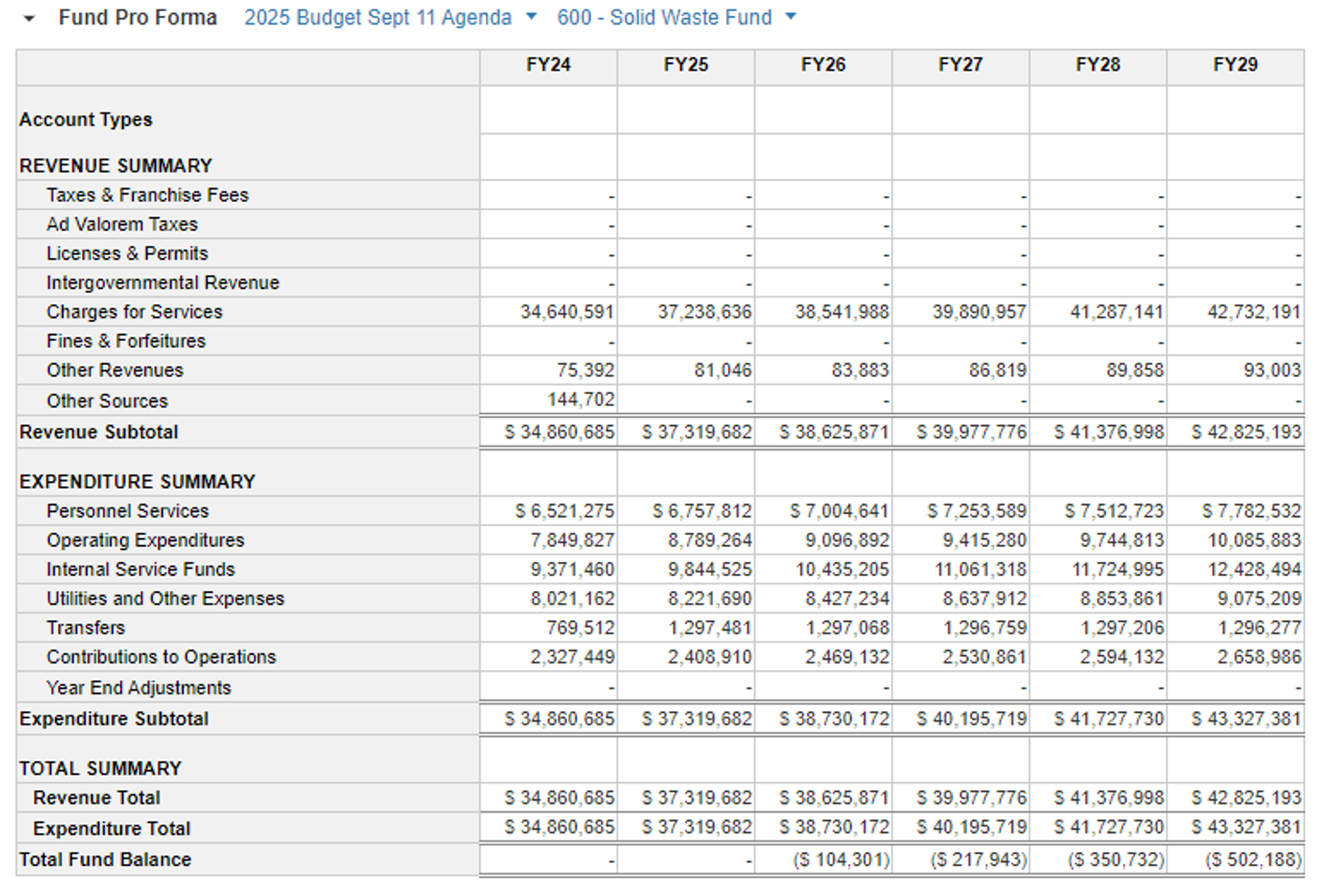
See additional views of FY25 budget in OpenGov
See additional detail of the Five-Year Fund Pro Formas.
Estimated revenues and expenditures for FY25-FY29 generally reflect revenue projections and current expenditure levels escalated by a CPI factor and indicate how expected trends applied to current estimates will shape future budget planning.
Budget Highlights
FY25
- The fund is self-sustaining and is funded with monthly service fees
- Solid Waste rates are reviewed every three to four years to ensure cost recovery over the planning period.
FY26-29
The City completed a rate study for the Solid Waste Fund in FY23, and the rates went into effect at the start of FY24.

See additional views of FY25 budget in OpenGov
See additional detail of the Five-Year Fund Pro Formas.
Estimated revenues and expenditures for FY25-FY29 generally reflect revenue projections and current expenditure levels escalated by a CPI factor and indicate how expected trends applied to current estimates will shape future budget planning.
Budget Highlights
FY25
- Operating revenues and expenses were adjusted by CPI at 3.4% for FY25 and included a $3.7 million transfer to the Stormwater Renewal, Replacement, and Improvement (RR&I) Fund.
- In FY25, operating expenditures were analyzed and redistributed based on a historical three-year average to reflect anticipated costs more accurately and incorporated budget assumptions from management adjustments.
FY26-29
- Assumptions for rate revenues include modest customer growth of 1% and CPI set at 3.4% for FY25 and 2.5% from FY26 through FY29.
- Operating expenses are estimated to increase by 2.5% through FY29.
- Emphasis on maximizing the RR&I transfer through reducing operating expenses will continue to be monitored each year.

See additional views of FY25 budget in OpenGov
See additional detail of the Five-Year Fund Pro Formas.
Estimated revenues and expenditures for FY25-FY29 generally reflect revenue projections and current expenditure levels escalated by a CPI factor and indicate how expected trends applied to current estimates will shape future budget planning.
Budget Highlights
FY25
- In FY25, the Golf Department will continue to provide outstanding services to the community at its current staffing level.
- Revenues are expected to increase slightly in FY25 due to membership growth and greens fees.
- Total expenditures are also expected to be slightly higher in FY25 due to the consistent amount of rounds played and the increase in the cost of goods and personnel.
- Golf course management plans to install new netting and sod at the driving range in FY25.
FY26-29
- With an increase in rates and memberships and a steady amount of rounds played, revenue growth is expected over the next four years.

See additional views of FY25 budget in OpenGov
See additional detail of the Five-Year Fund Pro Formas.
Estimated revenues and expenditures for FY25-FY29 generally reflect revenue projections and current expenditure levels escalated by a CPI factor and indicate how expected trends applied to current estimates will shape future budget planning.
Budget Highlights
FY25
- Staff continues to monitor the Perpetual Care Trust Fund (PCTF) drawdown by tracking maintenance costs, evaluating the current inventory of burial spaces, and engaging in a burial plot buyback program to provide additional spaces to replenish the trust fund.
FY26-29
- Funding for the PCTF is subject to estimates of future sales of grave spaces and maintenance expenditures.
3.1 Financial Schedules
This section contains links to the OpenGov transparency portal that the City of Tallahassee uses to share
financial and budgetary information. The strength of the platform lies in the power of the viewer to see
the budget from any
angle. Select the links below as starting points.
3.2 Fund and Reserve Balances
Click here for the Capital Fund Balance Report
Click here for the Schedule of Reserves

FY24 Closeout Statements by Fund
The final closeout statement for each fund is presented below with information on service levels, year-end amendments for balancing, and further monitoring for FY25.
General Fund
The General Fund ends FY24 with revenues and expenditures in balance at $201,611,188.
The General Fund includes 23 service departments. The two largest are the Tallahassee Police Department ($71.2 million) and Parks and Recreation ($30.6 million). These two departments comprise 50% of the General Fund. Other services in the General Fund include public infrastructure planning and engineering, community beautification and right-of-way maintenance, growth management, comprehensive planning, housing, community resilience, and others that support the community and the organization. Transfers from the General Fund for debt payments, capital project funding, and contributions to StarMetro, the Consolidated Dispatch Agency (CDA), and Community Redevelopment Funds (CRAs) total $41 million, 20% of the total budget.
General Fund Revenues
American Rescue Plan Act (ARPA)
The American Rescue Plan Act (ARPA), signed into law on March 11, 2021, authorized $1.9 trillion in State and Local Fiscal Recovery Funds (SLFRF) to speed up the United States' recovery from the economic and public health impacts of the COVID-19 pandemic. The State of Florida received $17.6 billion, and, as an eligible municipality, the City of Tallahassee received $46.2 million to spend over four calendar years, 2021 through 2024.
On May 19, 2021, the City Commission approved a summary plan for the funds designed to accomplish the goals of the Act, with funding allocated to three critical areas: public health response, economic recovery, and revenue loss recovery.
As the funding period draws to a close, the success of the City’s plan for ARPA funds is clear. In the wake of COVID-19, these funds were critical to the community's recovery, with $18 million in direct investment in affordable housing, homelessness, community services, neighborhood resilience, public health response, and economic recovery. The General Fund would have faced a loss of $29.4 million over four years, which would have required reductions in critical service areas such as police, parks and recreation, and public infrastructure.
Closeout actions include establishing projects to ensure all remaining ARPA balances are encumbered and expensed per the grant deadlines. Following approval of the FY24 closeout, the City’s ARPA funding will be expended or encumbered in a way consistent with the program requirements.
The following highlights results for other significant revenues in the General Fund:
- Property Taxes (Ad Valorem) - Due to the ability of property owners to receive a discount on their taxes if they pay early, the City budgets 95% of the total tax levy to allow for the resulting revenue reduction. The City collected $1.1 million more than budgeted in FY24. At $67.2 million, property taxes (Ad Valorem) support 33.4% of the General Fund Budget.
- Contributions from Utilities were received as budgeted and, at $53 million, funded 26.3% of the General Fund budget. Each year, the contributions from utilities escalate by CPI per ordinance.
- Public Service Taxes - At $28 million, Public Service Taxes make up 14% of General Fund revenues. In FY24, they exceeded the prior year’s actuals by $2.3 million.
- State of Florida Revenue Sharing and Florida Half-Cent Sales Tax revenues exceeded estimates by $1.2 million, reflecting higher growth than anticipated.
- Charges for Services revenues totaled $13.6 million in FY24, including $6 million in parks, recreation, and animal services fees, $2.7 million in parking fees, $2.5 million in traffic and right-of-way maintenance agreements, and $1.1 million in planning fees.
Overall, the variance between the budgeted and actual revenues was less than half a percent, indicating that the methods and projections used to establish the budget are reliable.
General Fund Expenses
Throughout FY24, inflationary pressures on the General Fund, such as increased labor costs, the cost of fuel, and ongoing supply chain issues, were closely monitored. Due to responsive operational decisions from City departments throughout FY24, the General Fund ended the year by balancing revenues and expenditures and keeping operations within budget parameters.
StarMetro
The City has operated StarMetro, a public transit system, since December 1973. StarMetro provides fixed routes and special transportation services under the Americans with Disabilities Act (ADA) provisions and serves as the Community Transportation Coordinator (CTC) for Leon County. Its services include 14 crosstown routes, eight university routes for FSU, student ridership programs for FAMU, TCC, and K-12 Leon County students, and paratransit.
The StarMetro Fund for FY24 ended balanced at $21.6 million, with a transfer from the General Fund of $5.6 million.
Building Inspection
The Building Inspection Fund ended FY24 at $5.5 million. Pre-closeout, revenues exceeded expenses by $496,489, which increases the Building Inspection Reserve Fund per State Law.
The City's Growth Management Department enforces the building codes by reviewing building plans, permitting, and the inspection process. Specific actions include ensuring that planned construction complies with applicable codes, authorizing utility connections and issuing certificates of occupancy, providing centralized intake and coordination of all permit applications, administering contractor licensing regulations, and enforcing the rooming house ordinance.
As a self-balancing fund, reserves are maintained in the Building Inspection Fund to provide for the variability of building activity. In FY23, permit and review fees increased per Resolution 22-R-25 to ensure full recovery of costs as budgeted. Starting in FY24, fees increase annually by the Consumer Price Index. As building permitting is variable due to economic impacts over time and legislative changes, the Building Fund will continue to balance recovery of costs and building fund reserves to deliver services.
Fire
The Tallahassee Fire Department (TFD) provides the City of Tallahassee and Leon County with quality fire suppression, specialized hazardous material response, emergency management, facilities security, focused urban search and rescue; dedicated technical rescue, superior vehicle extrication, high-quality emergency medical care, fire safety code compliance review and enforcement, and varied public education services. Beyond Leon County, the department also provides emergency response via mutual aid to communities in the surrounding area. Within TFD, Emergency Medical Technicians (EMTs) receive Basic Life Support (BLS) training for trauma care, cardiac and stroke care, CPR, advanced first aid, childbirth, and basic medication administration. TFD's paramedics are ALS-certified and responsible for managing the emergency medical scene according to protocol.
The Fire Operating Fund ended FY24 with a surplus of $2.1 million, which, per policy, increases the Fire Operating Reserve at year-end. In FY23 and FY24, revenues were $1 million less than assumed in the most recent Fire Service Fee study. Additionally, a new three-year collective bargaining agreement was approved beginning in FY25, resulting in additional costs beyond what was assumed in the fee study. These factors will require an early review of the Fire Service Fee in FY25 and a potential increase beginning in FY26.
Electric & Gas Utility
Electric
The Electric Utility serves over 120,000 customers in a 221-square-mile service territory. It is the fourth-largest municipal electric utility in Florida and the 27th-largest of over 2,000 municipal systems in the United States. The utility comprises six major divisions: Financial and Administrative Services, Power Delivery, Energy Supply, System Operations, System Compliance, and System Integrated Planning. The Electric Utility develops a 10-year sales forecast annually to use in the annual budget process. Various inputs, such as heating and cooling days and economic and population growth, are used to develop the sales forecast. The weather is the most variable driver. As the year progresses, actual sales guide the utility's operational decisions. Warm weather, especially during the spring and summer, increased retail demand slightly above the forecast.
Hurricane Debbie caused 14,000 outages in August and Hurricane Debbie caused 52,000 outages in September. Overall, power was restored within 36 hours thanks to staff and mutual aid efforts. The storms will have had little fiscal impact on the FY24 closeout. In May 2024, several tornadoes touched down and ran through Tallahassee, causing significant damage to the Electric system and leaving over 70,000 customers without power, with most customers restored within 7 days. Restoration efforts totaled over $18 million, with 87% of the cost recovered from FEMA and the Florida Department of Emergency Management. The Electric Construction Fund (RR&I) funded restoration costs, minimizing impacts on FY23 results.
Gas
Since 1956, the City of Tallahassee's Gas Utility has provided clean, safe, economical, and reliable natural gas to residents and businesses in our growing service area. The Gas Utility supplies natural gas through 965 miles of underground gas mains, which serve over 34,000 service points in Leon, Gadsden, and Wakulla counties.
The Gas utility continues to receive high ratings from customers in satisfaction surveys. The Commission passed a new gas-hit-line fine in FY23 to fund community education programs and outreach, which prevents future line damage, reducing costs and incidents involving the Utility’s infrastructure.
Warm weather during FY24 had a minor impact on sales, with consumption slightly lower than projected. However, careful management of operating expenses kept the Gas Utility under its established budget. At year-end, revenues exceeded expenditures, with the excess retained in the Gas RR&I Fund for future investments in Gas infrastructure per Financing the Government Policy 224.
Underground Utilities
Water Fund
The City's water system currently services over 88,000 connections and consumes approximately 9 billion gallons of water annually. This around-the-clock operation employs 27 water wells and treatment facilities, eight elevated storage tanks, 7,437 fire hydrants, and 1,247 miles of water distribution pipes.
The Water Fund for FY24 is balanced at $50.6 million, with the requested action to transfer the surplus of $1.75 million first to the Water Operating Reserve for $47,749 and the remaining $1.7 million to Water’s RR&I fund. Operating reserve funds are established to account for variability and ensure the utility can meet its General Fund contribution. The rate study completed in FY24 anticipated budget assumptions to balance revenue requirements with a multi-year plan, replenish reserves, and stay within the parameters of the rate study.
Sewer Fund
The City’s Wastewater Utility is responsible for collecting, treating, and recycling wastewater and treating commercially pumped sewage. As part of the City’s commitment to protecting the environment, treatment processes utilized at the Thomas P. Smith (TPS) Advanced Water Reclamation Facility result in effluent that meets and exceeds regulatory requirements. On average, the sewer system collects and treats more than 17.2 million gallons daily. On average, the sewer system collects and treats more than 17.2 million gallons daily.
The Sewer Fund ended FY24 balanced at $91.7 million, which includes a transfer from operating reserves of $546,788. This result for FY24 is within the parameters of the last rate study.
Stormwater
The Stormwater Utility serves approximately 77,000 residential and 6,000 non-residential customers through operational activities and the design and construction of drainage facilities infrastructure. The fund includes capital project oversight, maintenance of drainage infrastructure such as retention ponds and drainage outfalls, monitoring of lakes and groundwater, and raising public awareness of the environmental impacts of pollution, such as the Think About Personal Pollution (TAPP) program.
The Stormwater Fund ended FY24 balanced at $24 million, which includes a transfer to RR&I of $1.8 million per policy. This result for FY24 is within the parameters of the last rate study.
Aviation
The Aviation Fund supports all six Aviation Department divisions and services that support the Airport and its operations. The Airport Fund is self-supporting and requires no support from the general government. Revenue sources for the Airport include airline charges, airport parking, rental car concessions, retail and dining concessions, and the rental of leased property. The key drivers are enplanements, deplanements, and aircraft operations. Total revenues have increased over the past four years, including a $1.2 million increase in revenue in FY24. The increase is primarily due to a return to pre-pandemic airport traffic, including increases in Rental Car and Parking Lot Revenues. Several capital projects are ongoing at the airport, including the International Processing Facility, Parking Lot Lighting Improvements, Runway 9-27 Rehabilitation, Main Terminal Central Chiller Replacement, and Taxiway Bravo Rehabilitation.
The Aviation Fund ended FY24 balanced at $19.4 million. Surplus revenue funds were transferred to the Airport RR&I fund and Airline Revenue Sharing in accordance with the Airline Use and Lease Agreements implemented in FY23.
Solid Waste Fund
The Solid Waste Fund provides garbage, recyclable materials, bulk, and yard waste collection for all residential customers citywide, as well as garbage and recyclable materials collections for commercial customers. Currently, the City serves 74,061 service points – 62,545 residential, 9,668 commercial, and 1,848 commercial recycling.
The closeout summary below shows that the Solid Waste Fund ended FY24 balanced at $38.5 million, including a $772,595 transfer to the Solid Waste Operating Reserve per Financing the Government Policy 224.
Golf
The Golf Fund supports Hilaman Golf Course, which offers a community-wide golf experience through daily rounds, driving range use, charity events, tournaments, and more. Hilaman also has a Pro Shop, restaurant, and event space that provide a well-rounded experience.
Rounds played and membership fees remain the revenue drivers for the Fund, while an increase in driving range usage also provides an additional source. FY24 continued the trend of past years, with the amount of revenue received from rounds played continuing to increase. Revenues from the driving range also remain a constant revenue source.
The May Tornado event caused the course to close for several weeks. The driving range also suffered severe damage, leading to its several-month closure. This combination led to a minor decrease in total revenue for the year. However, before the storm, the Golf Fund was trending to increase revenues from FY23. As a result, staff monitored and controlled expenses to ensure the Fund remained in good standing.
The Golf Fund ended FY24 balanced at $1.3 million and includes a transfer of $184,966 to RR&I per policy.
Cemetery
The Cemetery Fund ended FY24 balanced at $423,111, which includes a transfer from the Cemetery Perpetual Care Fund of $228,192. Staff continues to monitor the Perpetual Care Trust Fund (PCTF) drawdown by tracking maintenance costs, evaluating the current inventory of burial spaces, and engaging in a burial plot buyback program to provide additional spaces.
3.4 Long-range Financial Plans
This section directly connects the financial sections of the strategic plan and addresses other financial issues with a long-term outlook.
Click the objectives or initiatives below to monitor these plans progress.
- Target 1-A-6: Invest $25 million through 2024 in stormwater capacity enhancements to improve water quality and mitigate flooding in the urban service area.
- Target 3-D-1: Percent of general employee pension funded. 90%
- Target 3-D-2: Percent increase of annual grant awards. 5%
- Initiative 3-D-1: Maintain a fully funded deficiency fund in accordance with City policy.
- Initiative 3-D-2: Maintain best-in-class municipal “AA” Bond rating.
- Target 4-C-3: Invest $44.9 million in the enhancement and maintenance of the potable water system over the next five years.
The goal of this legislation was to ensure that Floridians make a “living wage.” The Massachusetts Institute of Technology’s Living Wage Calculator shows that, for the state of Florida, the “living wage” for a household with one adult and no children is $22.43 an hour in 2024, a significant increase from the past few years.
The City Commission approved a minimum living wage of $12 per hour in Fiscal Year 2018 for all full-time employees. The City Commission expanded the application in Fiscal Year 2019 to include OPS employees (those who work more than 30 hours a week on average and are eligible for health care coverage). In Fiscal Year 2024, the City Commission approved increasing the City’s minimum wage to $16.
In 2020, over 60% of Florida voters approved a ballot initiative to gradually raise the minimum wage. In 2021, the wage was set at $10 per hour. This minimum wage will increase by $1 annually until 2026 when it reaches $15 per hour. Currently, as of September 2024, the statewide minimum wage is $13 an hour.
Tallahassee's City Comission approved increasing the minimum living wage to $17 per hour for all permanent and OPS employees for Fiscal Year 2025.
As state law, market conditions, and cost of living continue to change, the City will adapt its approach to maintain a high standard of living for its employees.
Healthcare benefits are essential to providing a competitive compensation package to attract and retain employees. Healthcare costs for employees are currently split by the employer and employee, with the City covering an average of 80% of the expenses for general employee plans. This 80/20 split is a change phased in from the 70/30 split in FY20. This reduction results in higher take-home pay for employees and will annually reduce the impact of healthcare cost increases.
Employees also received an increase in Flexbucks in FY22 of 9% or $177 annually to $2,145. Flexbucks are a monetary allowance that can be used towards healthcare contributions or adjacent voluntary benefits such as dental, vision, and life insurance. Employees will continue to receive $2,145 of FlexBucks in FY25.
FY2025 BUDGET OVERVIEW 4.0
CAPITAL AND DEBT
4.1 Capital Improvement Plan

The FY25 - FY29 Capital Improvement Plan includes a total of 195 projects over the 5 year span adding up to $1,220,767,322. With the successful adoption of the FY25 operating and FY25 - FY29 Capital budgets in September 2024, the FY25 appropriated amount includes 153 projects totaling $302,367,858. Some highlights of the current Capital Improvement Plan include the Fire Station 17 – Lake Bradford Road, Public Safety Campus and the Southside Triangle Water and Sewer Infrastructure. Click here to review the Capital Improvement Plan.
Capital Improvement Plan and Budget Process
Capital expenditures are related to the building, purchase, or maintenance of fixed assets that belong to the City of Tallahassee. Fixed assets have a useful life of more than one year and, to be included in the five-year capital budget, generally have a value of $50,000 or more. Other, smaller capital items are included in the department's operating budget as a capital outlay.
The City uses capital budgeting to ensure the proper maintenance and investment in its infrastructure. In selecting projects to fund, departments evaluate the impact of the project in achieving strategic objectives in the identified priorities: economic development, impact on poverty, organizational effectiveness, public infrastructure, public safety, and public trust. The development of the capital improvement plan (CIP) is continuous as departmental project managers evaluate the timeline of each project and maximize the use of available funding throughout each year. Each year the five-year capital plan is updated and adopted by the Commission along with the operating budget.
Department staff, Resource Management, and the Treasurer-Clerk’s office collaborate on funding for capital needs using a combination of cash and debt as appropriate within policy and credit rating standards.
In a typical year, Resource Management presents an initial capital budget with the proposed operating budget to the Commission to receive input from the community and feedback from the Commission.
Impact of Capital Investments on Operating Budget
Operating budgets supply the funding for capital expenditures. Multi-year capital financing plans are implemented to spread the cost of these projects over their useful life, financing them with annual transfers for debt service on capital or utility bonds as well as transfers to Repair, Replace and Improve (RR&I) funds. This allows operating funds to adjust for the cost of capital financing incrementally from year to year, matching the flow of revenues to capital expenses.
4.2 Funding Sources
for the Capital Budget
The City’s debt policy identifies debt-financing goals the City seeks to achieve. It provides targets rather than requirements and applies to all debt issued by the City of Tallahassee. The policy also addresses debt structure, debt issuance, debt refunding, debt targets, and other topics.
Bond Proceeds are funds received through bond revenue to pay for water, wastewater, electric, gas, and general government capital infrastructure projects. Bond proceeds in this year’s capital improvement plan include:
- Aviation Future Debt
- Fire Future Debt
- Future Capital Bond Series
- Future Sales Tax Bond
- Internal Loan Fund
- Sewer CUS Future Bonds
- T&I Future Debt
- Water CUS Future Bonds
General Government is funding received from the general fund, sales tax, gas tax, and intergovernmental funding with Leon County. These sources fund general government capital improvements including public infrastructure, public safety, technology advancements, and traffic infrastructure. General Government funding sources used in this year’s capital improvement plan include:
- Blueprint Annual Allocation - Sidewalks
- Concurrency - District 2 SE - Road
- Gas Tax
- General Government Capital Project Account (GGCPA)
- Intergovernmental
- Sales Tax 2020
Special Fundsderive from various sources including internal service capital funds, charges for services dedicated for capital improvements, proceeds from sales, accounts receivable funds, and reserves. Special funds used in this year’s capital improvement plan include:
- 800 MHz (Communication)
- Aviation - Customer Facility Charge
- Aviation - Passenger Facility Charge
- Blueprint Annual Allocation - Aviation
- Blueprint Annual Allocation - Water Quality
- Electric A/R
- Fleet Reserve Fund
- Gas A/R
- Sewer System Charge
- Sewer A/R Fund
- Traffic A/R Fund
- Water System Charge
Renewal, Replacement, & Improvement (RR&I) funding is cash received from each department’s operating budget that is dedicated for capital improvements. Undesignated balances are accumulated through balances in closed projects, unprogrammed RR&I funding and interest earnings. Those RR&I funding sources used in this year’s budget include RR&I funding from originating from a variety of operating funds:
- Airport RR&I
- Electric RR&I
- Environmental Services & Facilities Management RR&I
- Fire Construction Fund
- Gas RR&I
- Sewer RR&I
- Stormwater RR&I
- Technology RR&I
- Water RR&I
State Funds include grant funding from State organizations that provide additional support to community initiatives. The following funding sources are dedicated to projects in this year’s capital improvement plan:
- Aviation - Florida Department of Transportation
Federal Funds include grant funding from Federal organizations that provide additional support to community initiatives.
- Federal Aviation Administration
4.3 Debt Goals and Targets
While the City does not have formal or legal debt limits, it does have goals and targets to ensure that it maintains a AA rating from credit reviewers.
- Maintain sufficiently high bond ratings to assure access to affordable credit and low-borrowing costs
- Ensure intergenerational equity by amortizing debt within the expected useful life of a project or asset
- Coordinate the City’s capital improvement program with its debt management policy to develop a coherent, long-term financing plan for the City’s capital funding needs
- Maintain flexibility for the future financial needs of the City
The City will monitor and report debt ratios annually and at the time of each debt issuance, and strive to structure debt to meet the following targets:
Targets for liquidity, operating margins and debt burden
General Fund
Liquidity: Spendable General Fund Balance of 15% of General Fund expenditures.
Debt Service as a % of Expenditures/Coverage Ratio: Net Debt Service to be less than 10% of General Fund Expenditures
Debt Burden: Debt as a % of Full Market Value in less than 2%
Consolidated Utility System
Liquidity: 150 days cash on hand
Debt Service as a % of Expenditures/Coverage Ratio: Debt Service Coverage of 1.50x or higher
Debt Burden: Debt as a % of Capital Assets less than 50%
Energy System
Liquidity: 210 days cash on hand
Debt Service as a % of Expenditures/Coverage Ratio: Debt Service Coverage of 2.0x or higher
Debt Burden: Debt as a % of Capital Assets less than 60%
Targets for the structure of the City’s debt portfolio at the time of issuance
General Fund
Average Life (Range): 10 - 15 years
Viable Rate (VR): 20%*
Rolling Medium Term Notes (RMTN): 20%*
Combined (VR/RMTN): 30%*
Consolidated Utility System
Average Life (Range): 15 - 20 years
Viable Rate (VR): 25%
Rolling Medium Term Notes (RMTN): 30%cccc Combined (VR/RMTN): 40%
Energy System
Average Life (Range): 15 - 20 years
Viable Rate (VR): 25%
Rolling Medium Term Notes (RMTN): 30%
Combined (VR/RMTN): 40%
*The City shall not exceed the greater of these percentages or $50 million individually for Viable Rate and Rolling Medium Term notes and $90 million combined for Viable Rate and Medium Term Notes at the time of issuance.
Renewal, Replacement, & Improvement (RR&I) funding is cash received from each department’s operating budget that is dedicated for capital improvements. Undesignated balances are accumulated through balances in closed projects, unprogrammed RR&I funding and interest earnings. Those RR&I funding sources used in this year’s budget include RR&I funding originating from a variety of operating funds:
- Airport
- Electric
- Internal Service Funds
- Gas
- Sewer
- Stormwater
- Water utilities
- Golf
4.4 Bond Ratings Report Card, Maturity Schedules, and Debt Service
Debt service is funding used to pay interest on outstanding bonds and pay the principal on maturing bonds. The impact of debt on the current budget can be seen through the City’s debt service.
Click here to review debt service by fund in OpenGov.
The City of Tallahassee proudly maintains its AA bond rating from credit agencies. Download the Bond Report to learn more about the report card below, including the issuance and maturity schedule.
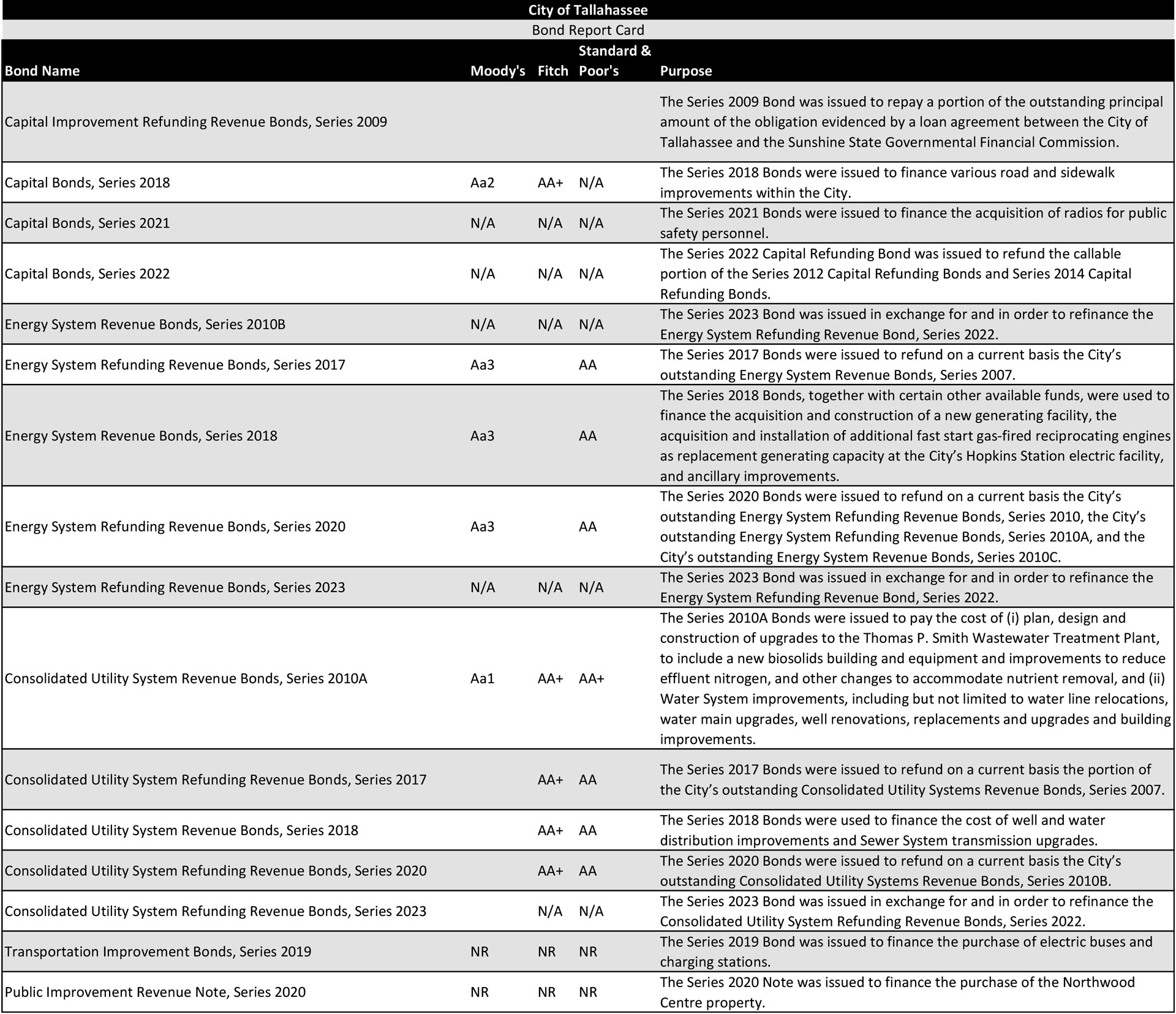
FY2025 BUDGET OVERVIEW 5.0
DEPARTMENTAL INFORMATION
5.1 Position Summary
The FY25 approved budget includes a workforce of 2,996.75 full-time equivalent (FTE) employees. This is an increase of 16.00 FTEs from FY24. In the Fire Department, 12.00 new FTEs are approved.
A reorg within Underground Utilities and Public Infrastructure (UUPI) moves the Water Quality Laboratory to Environmental Services, moving 18.00 FTE for a net zero impact. UUPI has requested 3.00 FTE as part of the rate study within the current rates of the FY25 CPI. Additionally, Aviation and Parks and Recreation have requested to convert 1.00 OPS to FTE.
FY2025 BUDGET OVERVIEW 6.0
APPENDIX
GFOA Budget Award
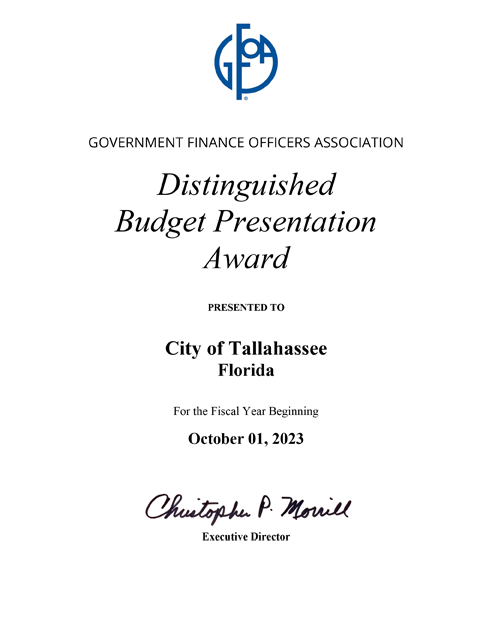
The City of Tallahassee was awarded the Distinguished Budget Presentation Award by the Government Finance Officers Association of the United States and Canada (GFOA) for the fiscal year 2024 budget, which is the 38th year the City of Tallahassee has received this award.
This award represents a significant achievement by the City. It reflects the commitment of the governing body, management, and staff to meeting the highest principles of governmental budgeting.
The City had to satisfy nationally recognized guidelines for effective budget presentation to receive the budget award. These guidelines assess how well an entity's budget serves as:
- a policy document
- a financial plan
- an operations guide
- a communications device
The budget presentation must be rated "proficient" in all four categories and the fourteen mandatory criteria within those categories to receive the award.
Special Thanks
Office of Economic Vitality
Office of Communications
6.1 Definitions
ACCRUAL BASIS - A basis of accounting in which transactions are recognized when they are incurred, as opposed to when cash is received or spent.
AD VALOREM TAXES - Taxes levied on both real and personal property according to the property's valuation and the tax rate.
ADVERTISING - Costs for legal advertisements, posters, publication of public notices, resolutions, ordinances, and bid invitations.
APPROPRIATION - A legal authorization to incur obligations and make specific expenditures.
AVAILABLE (UNDESIGNATED) FUND BALANCE - This refers to the funds remaining from the prior year which are available for appropriation and expenditure in the current year.
BAD DEBT - The estimated amount of accounts owed to the City (receivables) that will not be collected during the year. Bad Debt includes utility accounts, accident damage repair accounts, and other miscellaneous account receivables deemed uncollectible.
BALANCED BUDGET- The revenues must equal the expenditures. Florida Statute 166 reads, “The amount available from taxation and other sources, including balances brought forward from prior fiscal years, must equal the total appropriations for expenditures and reserves."
BOND - Evidence of the local government's obligation to repay a specified principal amount on a future maturity date, plus interest. Bonds are issued to obtain money for capital projects. Revenue bonds pledge a particular source of revenue usually generated by the new asset as the means of repayment.
BOND REFERENDUM - The process by which voters approve or disapprove a proposed general obligation bond issue.
BOND REFINANCING - The payoff and re-issuance of bonds to obtain better interest rates and/or bond conditions.
BOND RESOLUTION - The document by which the local government authorizes the sale of bonds.
BUDGET - The formal allocation of resources (dollars) to various programs with the intent of performing a service.
BUDGETARY BASIS - The basis of accounting used to estimate financing sources and uses in the budget. This generally takes one of three forms: GAAP, cash, or modified accrual.
BUDGET CALENDAR - The schedule of key dates the City follows in preparing and adopting the budget.
CAPITAL ASSETS - Assets of significant value and having a useful life of several years. Capital assets are also called fixed assets.
CAPITAL BUDGET - The appropriation of bonds or operating revenue for improvements to facilities and other infrastructure.
CAPITAL IMPROVEMENTS (Capital Projects) - Expenditures related to the acquisition, expansion, or rehabilitation of an element of the government's physical plant, sometimes referred to as infrastructure.
CAPITAL IMPROVEMENTS PLAN (CIP) - A plan for capital outlay to be incurred each year over a fixed number of years to meet capital needs arising from the government's long-term needs.
CAPITAL OUTLAY - Fixed assets that have a value of $750 or more and have a useful economic life of more than one year or assets of any value if the nature of the item is such that it must be controlled for custody purposes as a fixed asset.
CAPITALIZED OVERHEAD - Charges assessed to capital projects for administrative and labor-related services.
CAPITALIZED WAGES – Direct salaries or wages of city employees, which are paid from funds appropriated in the capital budget.
CASH BASIS - A basis of accounting in which transactions are recognized only when cash is increased or decreased.
CITY CONTINGENCY - Amount budgeted to meet unexpected operating expenditures during the current year.
COST OF GOODS SOLD (COGS) FUEL STORES - Fuel purchased by the city garage and then resold by the City for use in the city fleet.
COST OF GOODS SOLD (COGS) MATERIALS STORES - The cost of materials and supplies that the City resells. This includes articles for resale by the city garage parts division, the city warehouse, and golf courses.
COST OF GOODS SOLD (COGS) NATURAL GAS – In the Cost of Goods Sold account, the City records the cost of natural gas purchased by the City electric department to generate electricity and natural gas sold by the gas utility department to gas customers.
COLLECTIVE BARGAINING AGREEMENT - A legal contract between the City and representatives of a recognized bargaining unit for specific terms and conditions of employment (e.g., hours, working conditions, salary, fringe benefits, and matters affecting the health and safety of employees).
CONSUMER PRICE INDEX (CPI) - A statistical description of price levels provided by the U.S. Department of Labor. The index measures the increase in the cost of living (i.e., economic inflation).
CONTRACTUAL SERVICES - Services rendered to the City by private firms, individuals, or other governmental agencies. Examples include maintenance agreements and professional consulting services.
CURRENT SERVICE LEVEL (CSL) - A level of service which is the same as the current year.
DEBT SERVICE - The amount of money needed to 1) pay interest on outstanding bonds, 2) pay the principal on maturing bonds, and 3) make contributions to a sinking fund for term bonds. Debt service is calculated on a fiscal year basis.
DEDICATED TAX - A tax levied to support a specific government program or purpose.
DEFICIT - The excess of an entity's liabilities over its assets or the excess of expenditures or expenses over revenues during a single accounting period.
DEPARTMENT – An organizational unit of government that is functionally unique in its delivery of services.
DEPRECIATION - Expiration in the service life of capital assets attributable to wear and tear, deterioration, the action of the physical elements, inadequacy, or obsolescence.
EMPLOYEE BENEFITS - Costs incurred by the City for pension, health insurance, and other employee benefits.
ENCUMBRANCE - The commitment of appropriated funds to purchase an item or service. To encumber funds means to set aside or commit funds for a specified future expenditure. ENTERPRISE FUND - A fund established for services that are predominantly self-supported by user fees and charges.
EQUIPMENT SUPPLIES - The cost of materials and supplies used in the operation of machinery and equipment.
EXPENDITURE - The payment of cash or the transfer of property or services to acquire goods or services or settle a loss.
EXPENSE - Charges incurred (whether paid immediately or to be paid at a later date) for operations, maintenance, interest, or other charges.
FISCAL YEAR - Twelve months designated as an organization's operating year for accounting and budgeting purposes. The fiscal year for the City of Tallahassee is from October 1 through September 30.
FULL-TIME EQUIVALENT (FTE) - A method of measuring the number of authorized employees based on a full-time equivalent of 2,080 hours per year.
FUND - A fiscal/accounting entity established to accomplish specific objectives and activities. Examples include the debt service fund, capital projects funds, and special assessment funds.
FUND BALANCE - The excess of a fund's assets over its liabilities, reserves, and carryover.
GENERAL GOVERNMENT CAPITAL IMPROVEMENT FUND (GG/CIF) – Undesignated capital funding that serves as a contingency for all capital funding sources in the general government.
GENERAL GOVERNMENT CAPITAL PROJECT ACCOUNT (GG/CPA) – Funding from the general fund operating budget to support governmental capital projects.
GENERALLY ACCEPTED ACCOUNTING PRINCIPLES (GAAP) - Uniform minimum standards for financial accounting and recording encompassing the conventions, rules, and procedures that define accepted accounting principles.
GENERAL FUND - The fund used to finance all non-enterprise operations of local government.
GOAL - A statement of broad direction, purpose, or intent based on the community's needs. A goal is general and timeless. Glossary of Key Terms
GRANT - A contribution by a government or other organization to support a particular function. Grants may be classified as operational or capital, depending upon the intended usage of the grant proceeds.
INCREASED SERVICE LEVEL (ISL) - A change in service delivery that exceeds the current level of service.
INDIRECT COST - A cost necessary for the organization's functioning as a whole that cannot be directly assigned to one service.
INFRASTRUCTURE - The physical assets of a government (e.g., streets, waterworks, sewer lines, public buildings, and parks).
IN LIEU OF TAXES - Income received by local governments to compensate for the loss of revenue from a tax-exempt property.
INSURANCE - Costs associated with workers’ compensation claims, including administration and medical costs, dishonesty bonds, and property and casualty insurance premiums.
INTER-FUND TRANSFER - Legally authorized transfers from a fund receiving revenue to a fund through which resources are to be expended.
INTEREST EXPENSE - Cost of utilizing borrowed funds (long-term debt).
INTERGOVERNMENTAL REVENUE OR SHARED REVENUE - Tax/fee money collected by one level of government and distributed to another level of government.
INTERNAL SERVICE FUNDS - Funds established to distribute costs to user departments for administrative services provided by another unit of government, such as data processing or insurance funded from a central pool.
INTRA-FUND TRANSFER - Legally authorized transfers within a fund.
LEVY - To impose taxes for the support of government activities.
LONG-TERM DEBT - Debt with a maturity of more than one year after the date of issuance.
MILLAGE RATE - The rate in mills (1 mill = 1/1000 of a dollar or .001) at which property is taxed.
MISSION STATEMENT - A formal summary of the aims and values of a company or organization.
OBJECTIVE - A specific/quantifiable statement of what the City, a department, or a unit expects to accomplish in a fiscal year.
OFFICE EQUIPMENT - Furniture, fixtures, and equipment with an initial cost of $750 or more.
OPERATING REVENUE - Funds received by the City as income to pay for ongoing operations, including taxes, fees, interest earnings, and grant revenues.
OPERATING EXPENSES - The cost of personnel, materials, and equipment required for a department to function.
ORDINANCE - Legislation enacted by the City Commission, which has the full force and effect of law within the municipal boundaries.
ORGANIZATIONAL CHART - A graphic representation of the structure of an organization, showing the relationships of the positions or jobs within it.
OTHER SALARY ADJUSTMENTS - Items of employee compensation that are not directly related to the regular or overtime hours worked.
OVERTIME - Compensation to eligible employees for hours worked beyond 40 hours within a specific workweek.
PAY-AS-YOU-GO BASIS - A term used to describe a financial policy by which capital projects (infrastructure) are financed from current revenues rather than through borrowing.
PENSION CURRENT – The City’s contribution to an employee pension plan for participating employees.
PENSION MATCHED ANNUITY PENSION PLAN (MAPP) - City contribution to the employee-matched annuity pension plan for participating employees.
PER CAPITA COST - Cost per unit of the population to provide a particular service in the community.
PERFORMANCE INDICATORS - Specific quantitative and qualitative measures of work planned by specific departments or programs.
PERFORMANCE MEASURE - Data collected to determine how effectively or efficiently a program achieves its objectives (performance indicators).
PRIOR-YEAR ENCUMBRANCES - Unpaid, legally binding obligations from previous fiscal years in the form of purchase orders, contracts, or salary commitments, which are chargeable to a prior appropriation and for which a part of that appropriation is reserved.
PRO-FORMA - The financial assumptions or projections for the 14 operating funds.
PROGRAM - A collection of activities directed at accomplishing similar objectives.
PROGRAM PERFORMANCE BUDGET - A method of budgeting whereby the services provided to the residents are broken down into identifiable service or performance units, and funding is appropriated for a given level of service.
PROPERTY TAX - An ad valorem tax based on the fair market value of real property (land and buildings) and personal property (business equipment). The county property appraiser determines fair market or "just" value as of January 1 of each year under F.S. Chapter 193.
REDUCED SERVICE LEVEL (RSL) – The reduction of the services provided by a unit of government.
REPAIRS, REPLACEMENTS & IMPROVEMENTS (RR&I) - The portion of the cost of fixed assets (excluding land) charged as an expense during a particular period due to expiration in service life, attributable to wear and tear through use and lapse of time, obsolescence, inadequacy, or other physical or functional cause.
RESERVE - An account used either to set aside budgeted revenues that are not required for expenditure in the current budget year or to earmark revenues for a specific future purpose.
RESERVE TRANSFER - Those payments are necessary to meet the current requirements for reserve funds adequately.
RESOLUTION - A special or temporary order of a legislative body that requires less legal formality than an ordinance or statute.
REVENUE - Money that flows into the local government. Revenue is recurring if it is received each fiscal year (e.g., sales taxes and property taxes) and nonrecurring if it is received irregularly (e.g., federal and state grants). The four main types of local revenue are taxes, user fees, licenses and permits, and intergovernmental revenue.
ROLLED-BACK MILLAGE RATE - A tax rate at which, applied to the current year’s tax base, will bring in the same amount of taxes as levied the prior year. Newly construction or other real property added to the preceding year‘s tax roll excluded.
SALARIES AND WAGES - Regular weekly and monthly compensation for work performed as defined by the personnel pay scale for position classifications.
SERVICE LEVEL - Services or products that comprise a given program's actual or expected output.
SOCIAL SECURITY - City contribution to employee Social Security for participating employees.
SPECIAL ASSESSMENT - A tax on property owners who receive a benefit not received by all other taxpayers.
SPECIAL REVENUE FUND - Special revenue funds are used to account for and report the proceeds of specific revenue sources that are restricted or committed to expenditure for specified purposes other than debt service or capital projects.
SUPPLEMENTAL APPROPRIATION - An additional appropriation made by the governing body after the budget year has started.
TAX BASE - The total taxable value of property within the local government's legal boundaries.
TAX ROLL - The master list of the assessed value of all taxable property within the government's jurisdiction. The list is certified to all local taxing authorities by the property appraiser by July 1 of each year.
TAXABLE VALUE - The assessed value of real property after exemptions are deducted.
TAXES - Compulsory charges levied by a government to finance services for the common benefit of the people.
TEMPORARY WAGES - Seasonal or temporary employees' compensation computed on hourly or monthly rates.
TERM BONDS - Bonds that comprise all or part of a particular bond issue that come due in a single maturity.
TRAVEL AND TRAINING - The cost of attending meetings, conferences, short conferences, etc.
TRUST FUND - A fund established to collect and distribute monies for a specific function or operation.
UNCLASSIFIED EQUIPMENT - New equipment not otherwise classified, including air conditioners, traffic signals, field stripers, water fountains, etc. This includes all tangible personal property to be purchased, with a value of $1,000 or more. As with all capital equipment, this equipment is subject to inventory control.
UNCLASSIFIED PROFESSIONAL FEES - The cost of personnel service under-expressed or implied contracts to individuals, companies, or corporations engaged as contractors to perform a specific professional or expert service for the City.
UNCLASSIFIED SUPPLIES - Consumable materials and supplies used in conjunction with projects or operations not explicitly classified.
6.2 Commonly Used Abbreviations
AHAP Affordable Housing Assistance Program
CAD Computer Aided Dispatch
CDA Consolidated Dispatch Agency
CDBG Community Development Block Grant
CHSP Community Human Service Partnership
CIP Capital Improvement Plan
CIS Customer Information System
COCA Council on Culture and Arts
COPS Community-Oriented Policing Services
CPI Consumer Price Index
CRA Community Redevelopment Agency
CUSB Consolidated Utility System Bond
DEP Department of Environmental Protection
DIA Downtown Improvement Authority
DRI Development of Regional Impact
EAP Employee Assistance Program
EEO Equal Employment Opportunity
EOC Emergency Operations Center
ERU Equivalent Residential Unit
EWD Equity and Workforce Development
FAA Federal Aviation Authority
FAMU Florida Agricultural and Mechanical University
FDEP Florida Department of Environmental Protection
FDOT Florida Department of Transportation
FEMA Federal Emergency Management Agency
FERC Federal Energy Regulatory Commission
FHWA Federal Highway Administration
FSU Florida State University
FTA Federal Transportation Administration
FTE Full-time Equivalent
GASB Governmental Accounting Standards Board
GF General Fund
GG/CIF General Government/Capital Improvement Fund
GG/CPA General Government/Capital Projects Account
GIS Geographic Information Systems
HOME Home Investment Partnership Program
HUD Housing and Urban Development
IAFF International Association of Firefighters
IRP Integrated Resource Planning
ISO Insurance Service Office
ISS Information Systems Services
JARC Juvenile Assessment Receiving Center
KWH Kilowatt Hour
LLEB Local Law Enforcement Block Grant
MAPP Matched Annuity Pension Plan
MGD Million Gallons Daily
MSA Metropolitan Statistical Area
MW Megawatt
MWBE Minority and Women Business Enterprise
NPDES National Pollution Discharge Elimination System
OEV Office of Economic Vitality
PASS Pedestrian and Street Safety
PBA Police Benevolent Association
PETS Permit Enforcement Tracking System
PLACE Planning, Land Management & Community Enhancement
PSC Public Service Commission
PUD Planned Unit Development
RFP Request for Proposal
RR&I Repairs, Replacements, and Improvements
SCADA System Control and Data Acquisition
SHIP State Housing Initiative Plan
SPRP Stormwater Pollution Reduction Program
TSC Tallahassee State College
6.4 Online Budget Feedback
Thank you for reading the City of Tallahassee’s budget. To foster its continuous improvement, please complete a short survey to provide some feedback. Click here to complete the survey.
6.5 Form of Government
The City of Tallahassee uses the council-manager form of government with a “leadership mayor”.
The mayor's role includes presiding at city commission meetings, serving as the ceremonial head of the government, serving as the official head of the City for civil processes, and executing legal documents. The mayor is also considered the political leader of the government and is involved in dialogues and negotiations with county, state, and federal officials. Tallahassee's mayor is not considered a "strong mayor" because the position has no veto power and represents only one vote on the city commission.
The mayor and city commission serve as the governing body of the City. They set broad policies and goals and establish the City’s Strategic. They also establish goals, approve the annual budget and approve tax rates. The mayor and city commissioners each serve four-year terms. The terms of office are staggered, with elections held in even-numbered years (two seats during Presidential election cycles, and two others - plus the mayor - in mid-term election cycles).
Regular city commission meetings are typically held twice a month to conduct city business and provide citizens with an opportunity to participate in the government process. In addition, the commission meets for workshops on specific issues. The city commission also appoints four officers to administer the duties of the city.
Four officers, appointed by the city commission, handle the administration of the City: city manager, treasurer-clerk, city attorney, and inspector general. The city manager oversees most City departments and administers the daily operation of the City. The treasurer-clerk administers records, taxation, and the City treasury. The city attorney serves as the City's legal advisor, prepares contracts, and represents the City in legal issues. The auditor reviews the policies, procedures, and accounting of City operations.
- City Manager Reese Goad
- Inspector General Dennis R. Sutton
- Treasurer-Clerk James Cooke, IV
- City Attorney Amy Toman
The independent Ethics Board was created in accordance with voters' approval of a City Charter amendment during the November, 2014 general election. Approval of the referendum created a 7-member Board comprised of 5 seats designated for appointment by local entities including the City Commission, Public Defender, State Attorney for the Second Judicial Circuit, President of Florida State University, and President of Florida A & M University. The referendum required these initial 5 Board members to select two additional members to bring the Board to a full complement of 7 members.
The independent Ethics Board and Ethics Officer provide ethical oversight of the City’s elected and appointed officials. Click here to visit their website.
6.6 Supplemental Demographic and Economic Information
This section offers additional information and visualizations related to the City’s community. It also describes economic trends that impact the City’s budget. For more information on these trends, please visit the Tallahassee-Leon County Office of Economic Vitality’s website.
The Tallahassee Metropolitan Statistical Area (MSA) is used frequently, which includes all of Gadsden, Jefferson, Leon and Wakulla counties. The City serves as an urban hub to these areas and many in outside communities work and shop within the City’s limits.
The example graph below shows the growth of median sales price of homes in Tallahassee, Leon County, and the State of Florida.
Educational Attainment
As of 2022, 47.5% of Leon County residents 25 years and over had obtained a Bachelor’s degree or higher, up from 41.7% in 2000. In comparison, 32.3% of State of Florida residents and 34.3% of US residents 25 years and over had obtained a Bachelor’s degree or higher. Some 49.9% of Tallahassee City residents had a bachelor’s degree or higher.
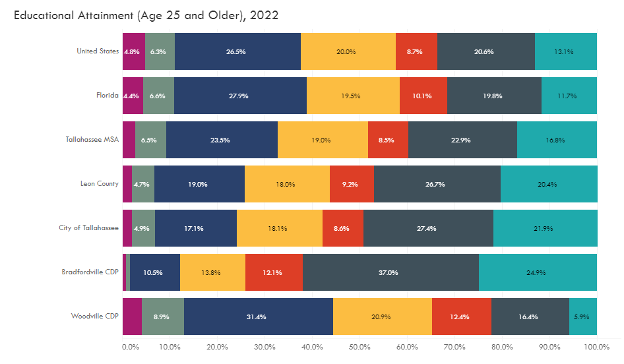
Explore the most recent data and interactive views.
Population by Age
The City boasts a large student population with 20 to 24 year-old residents representing the largest 4-year age group. With the areas around the universities resembling college towns, the student populations impact the City’s statistics from poverty to homeownership.
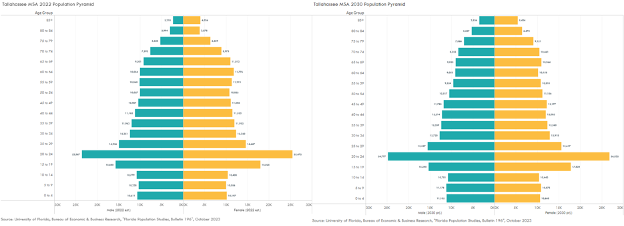
Explore the most recent data and interactive views.
Electric Service Points
The City’s electric utility serves more customers each year, which represents both growing revenues and costs for the Electric Fund. Regular spikes in the early fall are likely due to students moving in and out of properties in those months.
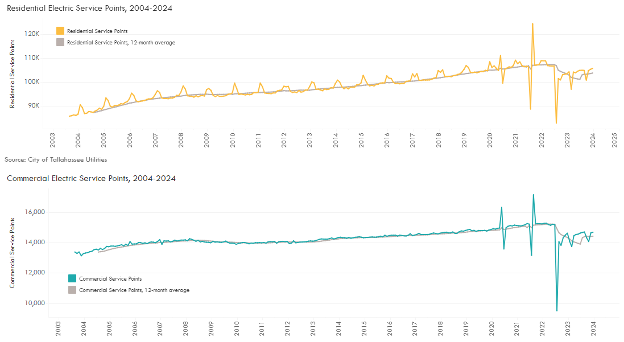
Explore the most recent data and interactive views.
Tallahassee Airport Passengers
The Tallahassee International Airport continues to serve as a catalyst for economic development in the region. Passenger traffic has recovered to reach pre-pandemic numbers, and the airport continues to see a consistent amount of cargo being enplaned and deplaned.
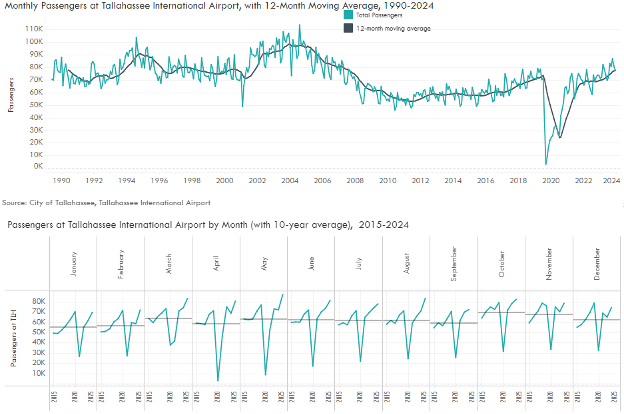
Explore the most recent data and interactive views.
|